MARRAKECH: THE OCHRE CITY
Identity card:
– History:
– Population :
– Geographic location:
– Climate :
Introduction :
PRACTICAL INFORMATION ABOUT MARRAKECH
– Best times to visit Marrakech:
– Dominant languages in Marrakech:
– Money and Budget:
– Flora and Fauna of Morocco:
– Transportation:
– Accommodation:
Our selection of the 10 best hotels in Marrakech:
Type of accommodation according to your budget:
– Health:
– Security:
GET TO KNOW MARRAKECH BETTER
Marrakech on the map.
Must-sees in Marrakech: What to do, what to see, what to visit?
1. Discover the magic of the Jemaa El Fna square:
2.Take a walk in the alleys of the Medina:
3.Admire the beauty of the Koutoubia Mosque
4.Ben Youssef Medersa, the Arab-Andalusian jewel
5.Bahia Palace, a little wonder on earth
6.Visit the Saadian tombs: The remaining vestiges of the Saadian dynasty
7.The El Badi Palace, a lost wonder
8.Dar Si Said: a palace turned Moroccan art museum
9.Appreciate the Museum of Marrakech, One of the Most Beautiful Architectures
10.The Majorelle Garden:
11.The Menara gardens: the oldest gardens in the West Muslim
12.The Palmeraie:
The corners to visit absolutely!
– The Jemaa El Fna square
– The Souks
– The Koutoubia Mosque
– The palm grove:
– The Ben Youssef Medrassa
– The Majorelle Garden
– The museum of Marrakech
– The Bahia Palace
Marrakech is more than just a culture
– Handicrafts:
Jewelry
The carpets
Ceramic and pottery
Wrought iron
The marquetry and the Thuya
Plaster and Zellige
The brassware
Tannery, leather, and leather goods
Traditional clothing
– Arts :
The great writers of Marrakech:
Marrakesh poetry
Painting in Marrakech
The architecture
The music
The gastronomy of Marrakech
– By regions :
– Our top 10 best restaurant selections:
– Agriculture:
Local products of Marrakech:
Fruits and vegetables of Marrakech:
– Economy:
5 essential tips to remember before departure:
Our selection of tourist activities:
Going out in the evening:
Explore the surroundings of Marrakech:
– Excursion to the Atlas Mountains to discover the Ouzoud waterfalls
– Discover the Agafay desert
– The Berber villages of the High Atlas
-Hot air balloon flight around Marrakech
-Sleeping in the desert of Marrakech
– Horseback riding in Essaouira
Camel adventures:
The 10 best discoveries of Marrakech
Marrakech for sports lovers
Golf:
Soccer:
Tennis:
Basketball :
Boxing:
Athletics:
Rugby:
Marrakech guide
MARRAKECH: THE OCHRE CITY
Identity card:
-History:
Marrakech, the red city, the pearl of the south, is the historical heart of Morocco. Its history began in 1062 with Youssef ben Tachfine, the third imam and the first sultan of the Berber dynasty of the Almoravids, considered to be the father of Morocco. His time was marked by the construction of several schools of Koranic theology, as well as several mosques. Thereafter, the Almoravid Caliph Sultan Almohad Abdelmoumen was inspired by the Mosque of the Giralda (in Seville, Andalusia) and built the Koutoubia Mosque.
In 1147, following the defeat of the Almoravids, the Almohads took over and destroyed all the religious buildings to rebuild new mosques, gardens, the Kasbah, and Bab Agnaou, which is one of the nineteen doors (Bab) of Marrakech, and they also created the first hospital of the city, which welcomed the scholar Ibn Rochd, known in the West under the name Averroes.
Thereafter, in 1269, the Merinids took over power and led the city towards decline, causing Marrakech to lose its role as the capital to the profit of Fez. With the arrival of the Saadians from Sous in 1554, Marrakech was able to regain its status as the capital of Morocco, and once again the city regained its glory as well as its former wealth, and several structures were built such as the El Badi Palace and the Saadian Tombs.
In 1669, Marrakech was taken by the Alaouites, and the city once again went into decline, losing the status of the capital to Fez. Following the Treaty of Fez of March 30, 1912, which established the French protectorate over Morocco, Thami El Glaoui, one of the famous Moroccan pashas, ruled in Marrakech.
During this time, the country made important economic progress thanks to the infrastructure put in place by the French, and the construction of the Medina of Marrakech was completed. In 1956, Morocco got its independence thanks to King Mohammed V, who later chose Rabat as the country’s capital.
- Population:
- Known as the 4th largest city in Morocco after Casablanca, Rabat, and Fez.
- Marrakech has an urban community of about 1.4 million inhabitants (June 2022) spread over an area of 230 km².
- Geographic location:
 It is Located in the center of Morocco, at the foot of the High Atlas Mountains. Marrakech has an ideal geographical position which makes it a crossroads between the north and the south of the country.
It is Located in the center of Morocco, at the foot of the High Atlas Mountains. Marrakech has an ideal geographical position which makes it a crossroads between the north and the south of the country.
- Climate:
The proximity of the Atlas Mountains means that Marrakech has a dry and warm climate throughout the year. In winter, the temperature can vary between 2 and 3°C at night and can rise to 25 and 26°C during the day. On the other hand, in summer, the weather can reach up to 45°C during the day and 38°C at night.
Introduction:
Marrakech is known as the red city, the pearl of the south, and the desert. Its name comes from the Amazigh words (Berber) Mour Akouch, which means the Land of God. This breathtaking land is rich in history dating back to 1062, with Berber and Arab-Andalusian art and architecture. It is a destination that entices and enchants tourists with its atmosphere, cultural wealth, incredible landscapes, colors, and geographical location that includes both snow, lush valleys, and desert. If you want to visit the capital of tourism in Morocco and North Africa, our tourist guide will help you enjoy your stay without wasting time.
PRACTICAL INFORMATION ABOUT MARRAKECH
To ensure a pleasant stay in Marrakech, our guide will save you time by providing all the useful information you need before coming to the “city of joy,” which has managed to combine culture and modernity while retaining its centuries-old charm.
- Best times to visit Marrakech:
You can visit Marrakech all year round, even in summer when the heat is at its peak and can reach up to 46°C. However, the best periods are autumn and spring, when the climate is pleasant, from March to May and from October to November. The temperature varies on average between 20 and 30°C during the day, and it is generally cooler in the evening. On the other hand, if you prefer cooler weather, the winter months will suit you best since the temperature is usually around 20°C during the day and drops below 10°C after sunset.
- Dominant languages in Marrakech:
Moroccans speak Arabic, specifically dialectal Arabic (Darija) because classical Arabic is only taught and used in school. Some Marrakchis also speak Berber, which is even more dominant among the mountain people. French is also commonly spoken as Morocco is one of the largest French-speaking countries in the world. Therefore, you will have no difficulty in making yourself understood, especially with young people, as this is the most touristy city in Morocco.
- Money and Budget:
The budget required for a week in Marrakech varies depending on the person and especially the season.
This table shows the different expenses according to the different budgets.
| Expenses | Simple budget / day / person | Medium budget / day / person | High budget / day / person |
| Accommodation | 15€ | 50€ | 120€ |
| Food | 12€ | 25€ | 60€ |
| Transportation | 1€ | 2€ | 3€ |
| Outing | 10€ | 20€ | 50€ |
| Shopping | 7€ | 15€ | 30€ |
- Flora and Fauna of Morocco:
The climate in Marrakech is hot and dry throughout the year, which is due to the city’s geographic location. For example, in the Agafay desert, you can find eucalyptus trees scattered everywhere, date palms, and oleanders, which are a type of shrub that is highly toxic. The region is also known for its pomegranate trees, olive trees, orange trees, and prickly pear trees. In terms of fauna, you can easily find beetles, scorpions, hoppers, grasshoppers, and many other insects in the area.
- Transportation:
Marrakech offers a variety of transportation options. To get to the city center from the airport, you have several options:
- Bus :
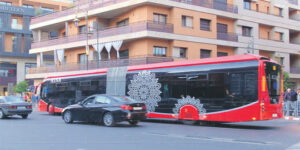
The bus is not the most convenient option, as it can be crowded. You should take the bus number that corresponds to your destination, and all trips cost 4dh. The medina is only 10km from the airport, and you can easily access it via bus n°19, which is located at the exit of the terminal just behind the taxi stand.
The one-way ticket costs 30dh, and the return ticket costs 50dh.
The bus is available every 30 minutes from 7 am to 9:30 pm.
- Taxi :
If you are at least two people, taking a taxi is a good alternative. The cost of a taxi from the airport to the Medina (Jemaa el Fna square) will be between 50 and 70dh (except at night), but you should negotiate the price. Taxis are the best way to get around the city. There are three types of taxis in Marrakech:
Small taxi move around inside the city, and their minimum fare is 7dh. They generally do not exceed 20dh in the city center, with a legal increase at night from 8 pm to 6 am from October to April and from 9 pm to 5 am from May to September. An average trip from Guéliz to Medina can cost between 40 and 60dh (except at night). Always make sure the meter is working, and if the driver refuses to start it, change the taxi (there are several available). In the worst case, negotiate the price if you are in a hurry.
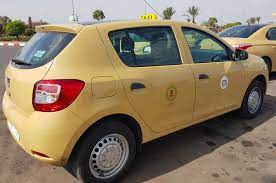
Grand taxis are allowed to leave the city. It is better to share them since they are much more expensive than petite taxis. For example, you can expect to pay a minimum of 120dh for a 15 to 20-km trip. It is always necessary to negotiate the price of the ride with the driver before getting into the taxi.
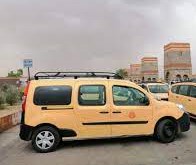
There are also green taxis, which are much more expensive than small taxis. The small cabs start with a meter base of 1.70dh during the day and 2.60dh during the night, while the green cabs begin their race with a base of 10dh during the day and 15dh at night. The advantage of the green cabs is that you only have to call 05-24-40-94-94, specify your location and your destination, and the taxi will pick you up. The fare will depend on your route.
- Train:
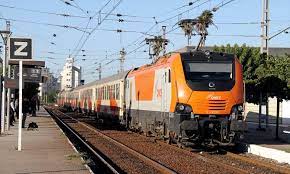
The train station is located in the Gueliz district. To get to Jemaa el Fna, you can take bus n°10, which costs 4dh, or you can opt for a taxi, which should not exceed 20dh (except at night). It should be noted that the minimum fare for the journey is 7dh, so it is always necessary to ask the driver to use the meter to avoid being ripped off.
- Carriage:
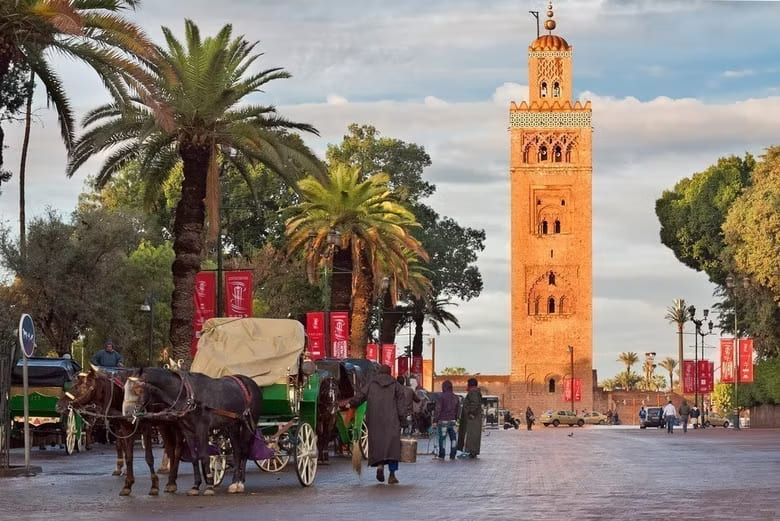
The horse-drawn carriage in Marrakech has kept its charm, and you should try it at least once during your stay. It costs 10 € per person for 1h30, and of course, always negotiate, especially if you are numerous. The main stop for horse-drawn carriages is at Foucauld Square, but you can find them elsewhere.
- Accommodation:
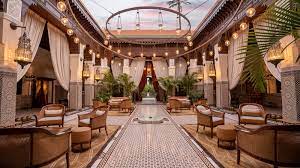
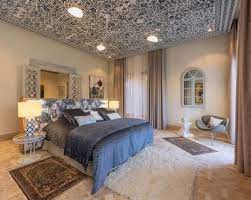
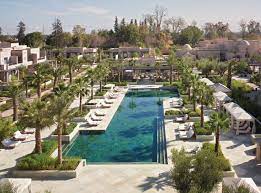
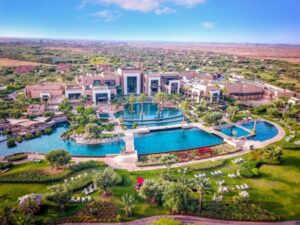
Marrakech, the ochre city, is one of the most touristic cities in Morocco, and it offers a variety of accommodation facilities. In Marrakech, you can find hotels of all categories, riads, guesthouses, villas, youth hostels, traditional houses in the Medina, and apartments in other parts of the city.
The idea is to book well in advance because you have a wide choice and can get better prices.
In Morocco, the usual check-in time for a hotel, a riad, a traditional house, or an apartment is 2:00 pm, and check-out time is between 10:00 am and 12:00 pm. So, if you arrive before 2:00 pm or wish to leave later than the scheduled time, you can ask for extra time or ask the hotel to keep your luggage safe while you roam the streets of Marrakech. However, you might need to pay an extra fee (especially if you are staying in a hotel) to visit Marrakech at your ease. (Be careful with your valuables.)
Our selection of the 10 best hotels in Marrakech:
- Four Seasons Resort Marrakech – 5 stars – (Address: Av. de la Ménara, Marrakech; telephone number: 05-24-35-92-00)
- Royal Mansour Marrakech – 5 stars – (Address: Rue Abou Abbas El Sebti; telephone number: 05-29-80-80-80)
- Fairmont Royal Palm Marrakech – 5 stars – (Address: Km 12 Route D’Amizmiz, Marrakech; tel: 05-24-48-78-00) Tigmiza Boutique Hotel & Spa – 5 stars – (Address: Douar Laghribate, Bab Atlas, Marrakech; telephone number: +212 5 24 39 37 00)
- Mandarin Oriental, Marrakech – 5 stars – (Address: Route du Golf Royal, Marrakech; telephone number: +212 5 24 29 88 88)
- La Sultana Marrakech – 5 stars – (Address: 403 Rue de La Kasbah, 63-67 Rue Boutouille, Marrakech; telephone number: +212 5 24 38 80 08)
- Selman Marrakech – 5 stars – (Address: Km5 Route d’Amizmiz, Marrakech; telephone number: +212 5 24 45 96 00)
- Hotel Dar Rhizlane – 5 stars – (Address: Avenue Jnane El Harti Hivernage, Marrakech; telephone number: +212 5 24 42 13 03)
- Hotel & Ryad Art Place Marrakech – 5 stars – (Address: Place Jemaa El Fna, entrance Riad Zitoun Lakdim, Medina, Marrakech; telephone number: +212 5 24 39 00 04)
- Es Saadi Marrakech Resort Palace – 5 stars – (Address: Rue Ibrahim El Mazini, Marrakech; telephone number: +212 5 24 33 74 00)
Type of accommodation according to your budget:
In Marrakech, you can find all types of accommodation according to different budgets.
If you want to stay in a popular area with cheap prices, you can opt for hostels located in the Medina that offer beds in dormitories at a reasonable price/quality ratio. The cost per person per night ranges from 8 to 16€, including breakfast. If you are traveling alone to Marrakech and have a small budget, this type of accommodation is the cheapest option, but note that it offers minimal comfort and privacy with shared bathrooms and a common restroom. It is recommended to bring earplugs for a good night’s sleep or even headphones if you don’t like to chat, as well as a power strip to avoid waiting in line if you want to charge your phone.
If you want to treat yourself with a medium budget while staying in the traditional heart of Marrakech (the Medina), you can rent a Riad, which is a miniature palace, a traditional house centered on an open-air patio with rooms, kitchen, and bathroom(s), a pool or fountain, and a terrace where you can enjoy breakfast while enjoying the magnificent view of Marrakech and the Atlas Mountains, or even a mint tea in the evening. The average daily rental price of the Riads varies between 45 and 85€, depending on demand and season. Riads are perfect for short stays.
Still in the Medina, you can find hotels with double rooms, with or without a swimming pool, ranging from 50 to 90€, depending on the season. You can also find apartments in the Guéliz district for the same price.
On the other hand, if you have a high budget and you are in love with the luxury, we suggest you go directly to the hotels in the Hivernage district, which is located in the south of the Guéliz district, or even the Palmeraie, which is far from the center and requires a car or a cab ride to get to the city center. For a double room in a luxury hotel in Marrakech, prices can range from 120 to 150 €, and for dream hotels, the prices can go up to 900 € depending on the season.
- Health:
To enter Morocco, travelers must have:
- A traveler’s health form must be downloaded online before boarding the ship or flight. It is compulsory to show the filled-out health form to the crew members when asked.
- A valid COVID-19 vaccination certificate, which is either the receipt of 3 doses or 2 doses, the 2nd of which must not exceed 4 months. It should be noted that only one dose of the J vaccine is equivalent to two doses of the other vaccines. Alternatively, travelers can show a negative result of an RT-PCR test taken less than 72 hours before boarding.
- Children under 12 are exempt from any requirements.
- Security:
In various tourist areas, it is best to:
- Avoid carrying valuables around
- Avoid being mugged
- Use taxis instead of walking in unfamiliar neighborhoods
- Avoid eating at any place, especially if you have poor health
- Adopt respectful behaviors toward others
- If you get lost in the streets, ask merchants for help
- Note that non-Muslims are not allowed to enter mosques.
GET TO KNOW MARRAKECH BETTER
Marrakech on the map.
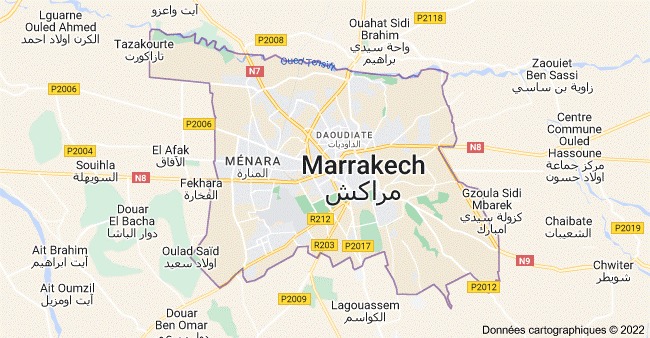
Marrakech Geography:
Marrakech, the pearl of the south, enjoys a particular geographical location. It is in the center of Morocco, at the foot of the High Atlas Mountains, which makes it a crossroads between the north and the south of the country.
The city is located 39 km south of the center of Marrakech in the Ourika Valley, 70 km from Mount Toubkal, the highest mountain in the High Atlas of Morocco and North Africa, with an altitude of 4167 m. It is also located 170 km from the Atlantic Ocean and about 180 km from the desert. It is the 4th largest city in Morocco after Casablanca, Rabat, and Fez and has an urban population of about 1.4 million inhabitants (as of June 2022) spread over an area of 230 km2.
Marrakech is an oasis rich in plant species, with 130,000 hectares of green spaces that have yuccas, various types of cacti, and papyrus, along with more than 180,000 date palm and banana trees. The region is also known for pomegranate, olive, orange trees, and prickly pear trees.
Must-sees in Marrakech: What to do, what to see, what to visit?
1- Discover the magic of the Jemaa El Fna square:
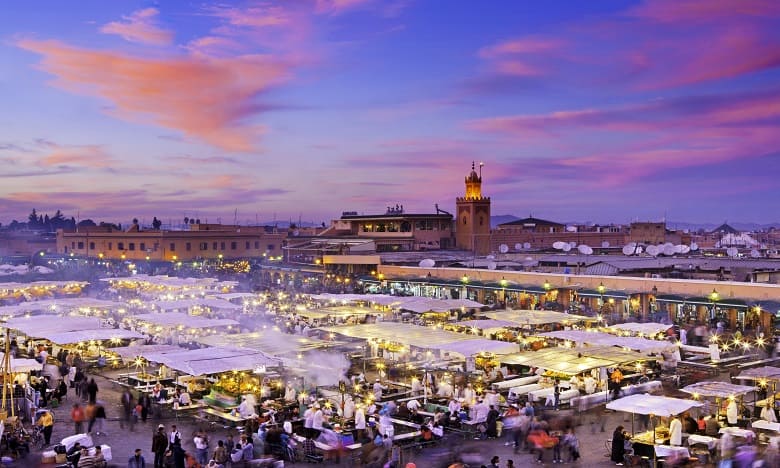
Located in the Medina, the Jemaa El Fna square is the living heart of Marrakech. It is the international symbol of the city and of Morocco since its foundation in the 11th century. Its name means “the assembly of the deceased.” At the time, this place was a site of justice and condemnation, where sentences were publicly executed.
Nowadays, the square has become a place of commerce and spectacle that attracts millions of visitors every year. During the day, there are horse-drawn carriages, water carriers, monkey showers, dancers, snake charmers, fortune tellers, charlatans, and all kinds of animations. It is around 7 pm that the real show begins, and it is at this time that the Jemaa El Fna square finds its charm through its street vendors and henna tattoo artists.
The smoke of cooking and the scents of traditional cuisine and barbecue invade the square. Jemaa El Fna Square is the best place to taste Moroccan specialties in a very pleasant atmosphere. Don’t forget to try some fruit juices, which are refreshing and budget-friendly.
2- Take a walk in the alleys of the Medina:
The Medina is the historical heart of Marrakech, and it has existed for nearly 10 centuries. The beauty of its architecture remains unique. It is in the Medina that we find most of the monuments, museums, Riads, as well as all kinds of souks which are traditional markets gathering in a great part of the Moroccan craft industry. In these souks, you can find different types of goods, namely fruits and vegetables, carriages, clothes, carpets, jewelry, pottery, leather, fabrics, spices, Moroccan pastries, lanterns, and many other items.
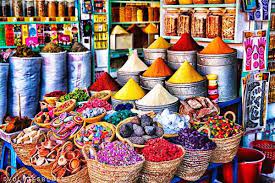
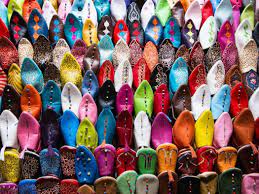
The Medina is divided into several souks, and each souk is specialized in a type of merchandise. For example, in Souk Ahiak, you can find everything that is fabric and clothing, in Souk Attarine, there are spices and brassware, while Souk Dhabia offers the sale and purchase of jewelry.
In Marrakech, everything is negotiable. You will notice that prices are usually not displayed, and they are set according to the customer’s bargaining power. If you like an item, you don’t have to pay the initial price, you can negotiate it. Don’t know how? It’s simple; you can usually reduce the proposed price by 40-50% and start the bargaining from there.
If the price still doesn’t suit you, don’t give up; you can try changing stores. You will surely find the same item in another shop. Generally, the merchants are very friendly and love to negotiate, especially with tourists. They take pride in their products and their knowledge, and they will try to convince you that
If the price still doesn’t suit you, don’t give up; you can try changing stores. You will surely find the same item in another shop. Generally, the merchants are very friendly and love to negotiate, especially with tourists. They take pride in their products and their knowledge, and they will try to convince you that their product is the best value for money and that you won’t find it elsewhere. They will not let you go until you take the desired item.
3- Admire the beauty of the Koutoubia Mosque
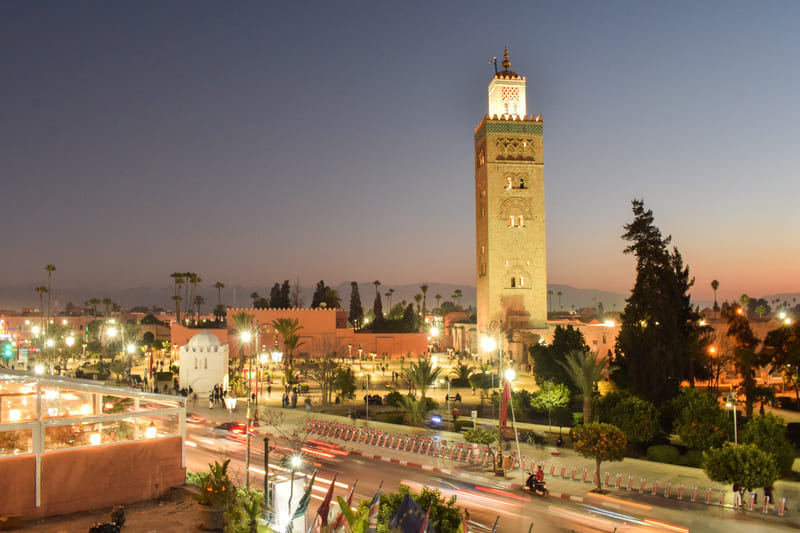
Located only 300m west of the Jemaa El Fna square (in the Medina), the Koutoubia Mosque is one of the most important mosques in Marrakech and is the symbol of the city par excellence.
In 1141, the construction of the Koutoubia Mosque began following the request of the Caliph Sultan Almohad Abdelmoumen, who was inspired by the Mosque of the Giralda (in Seville in Andalusia).
The mosque was completed in 1158. The Koutoubia Mosque, named after the many bookstores that surrounded it at the time, stands out with its 77m high minaret. It is one of the largest mosques in the kingdom and can accommodate up to 20,000 worshippers. Like all other mosques in the country, the entrance is strictly forbidden to non-Muslims, and therefore you can simply admire it from the outside.
4- Ben Youssef Medersa, the Arab-Andalusian jewel
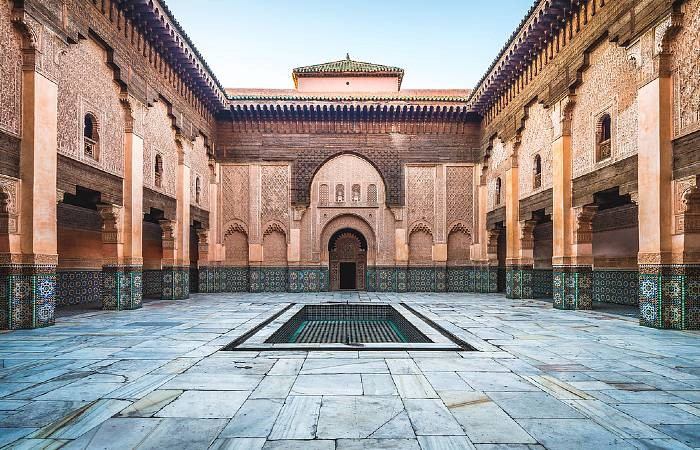
Located in the center of the Medina, the Ben Youssef Medersa is one of the most visited and admired sites, and its Moorish architecture leaves tourists speechless. The Medersa or the Koranic school is a Muslim theological school which is part of the bastions of Islamic culture. It is still the largest Koranic school in Morocco and North Africa.
The Medersa has 130 rooms that have accommodated up to 900 students. It was intended to be of service to the students of the mosque next door which had the same name (Ben Youssef).
The price to visit the Ben Youssef Medersa is 65dh for adults and 30dh for children. Generally, the visit lasts less than an hour, and the Medersa is open every day from 9 am to 5 pm.
5- Bahia Palace, a little wonder on earth
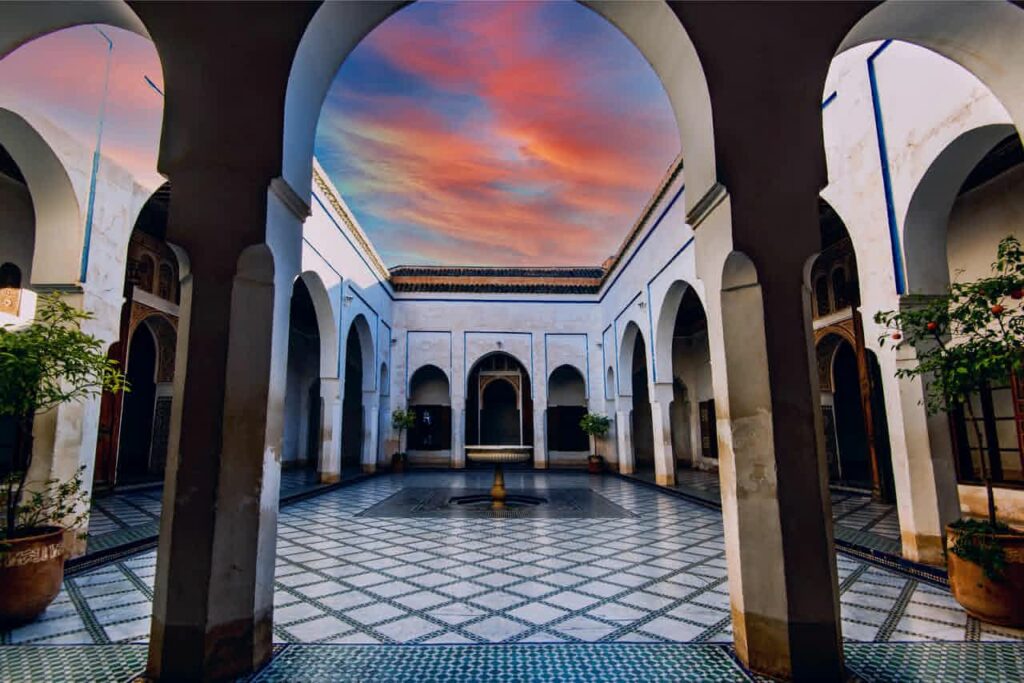
Built at the end of the 19th century (between 1866 and 1867) by Si Moussa, the vizier of Sultan Hassan I, for his personal use, the palace was given the name of “Bahia,” the name of one of his four favorite women, which means beautiful and brilliant. The palace was built with the intention of being the most beautiful and majestic Riad of his time to honor his wife La Bahia.
The 8-hectare palace is a true paradise, with 150 rooms overlooking courtyards as well as magnificent gardens where you can find orange trees, banana trees, flowers, cypresses, and jasmine.
Just after the death of Si Moussa in 1900, Sultan Abd Al-Aziz took over and plundered the Riad of all its luxury items. In 1912, following the French protectorate in Morocco, General Lyautey made the palace his personal residence. But after the declaration of Moroccan independence in 1956, King Mohammed V took over the Palace and decided to make it his own residence.
Subsequently, the Bahia Palace became the headquarters of the Foundation for National Cooperation until King Hassan II decided to entrust its management to the Ministry of Culture to transform it into a tourist attraction.
Today, only a part of the palace is accessible to visitors from 9 am to 5 pm for a fee of 70dh. The visit will take between one and two hours; it is better to go early, especially if you want to take nice pictures. The ceilings, made of notched cedar, plaster, Zellige, and shiny marble, will take your breath away.
The other part of the palace is reserved for the royal family.
6-Visit the Saadian tombs: The remaining vestiges of the Saadian dynasty
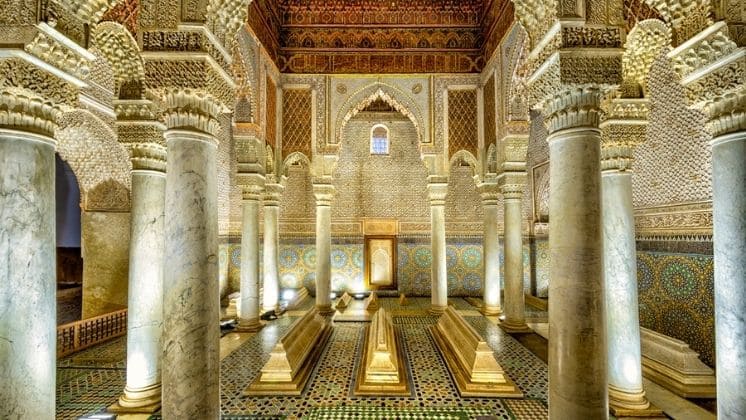
Built-in 1578 during the reign of Sultan Ahmed al-Mansur Saadi, the Saadian tombs were discovered only in 1917. The beauty and architectural richness of the tombs attract more and more visitors.
When the Alaouites arrived in Marrakech, Sultan Moulay Ismaïl (1654) decided to demolish all monuments that could recall the glory of the Saadian dynasty, including the El Badii Palace. However, when he arrived at the tombs, his superstition got the better of him, so he contented himself with hiding them rather than demolishing them.
The Saadian tombs are located next to the Kasbah Mosque and are one of the only remaining traces of the Saadian dynasty, an Arab dynasty that ruled Morocco more than 350 years ago.
The most important monument is the main mausoleum where Sultan Ahmad Al Mansur and his family are buried. In its courtyard, there are a hundred tombs decorated with mosaics where the most faithful warriors and servants of the same dynasty were buried.
You can visit this building any day of the week from 9 am to 12 pm and from 2:30 pm to 6 pm for a fee of 70dh per person. Generally, the visit does not exceed 30 minutes.
7-The El Badi Palace, a lost wonder
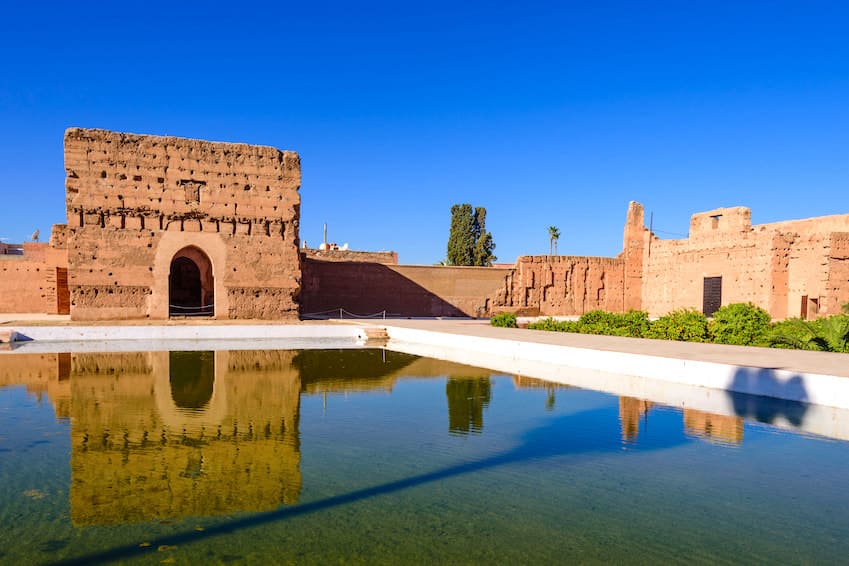
The El Badi Palace is an inspiration by the Alhambra in Granada and is one of the magnificent creations of Sultan Ahmed El Mansour Saadi. It was built by the latter in 1578 following Morocco’s victory against Portugal.
Its construction took a quarter of a century and was financed by a substantial ransom paid by the Portuguese after the Battle of the Three Kings. But after only 10 years of its existence, and with the arrival of the Alaouites in Marrakech, Sultan Moulay Ismaïl (1654) decided to demolish all the monuments that could recall the glory of the Saadian dynasty. The materials recovered during the demolition were used in the construction of Meknes, which later became the capital of the kingdom.
However, before its destruction by Sultan Moulay Ismail, the El Badi Palace was a marvel, with more than 350 rooms, patios, gardens, and a large swimming pool, besides, its name means the incomparable palace.
Unfortunately, today the palace is in ruins, with only the dilapidated walls remaining, and it is inhabited by storks and stray cats, but it serves as a venue for the Marrakech Laughter Festival.
You can visit this building any day of the week from 9 am to 5 pm for a fee of 75dh per person. It is necessary to inquire before going because the palace organizes events, and access may be restricted.
8-Dar Si Said: a palace turned Moroccan art museum
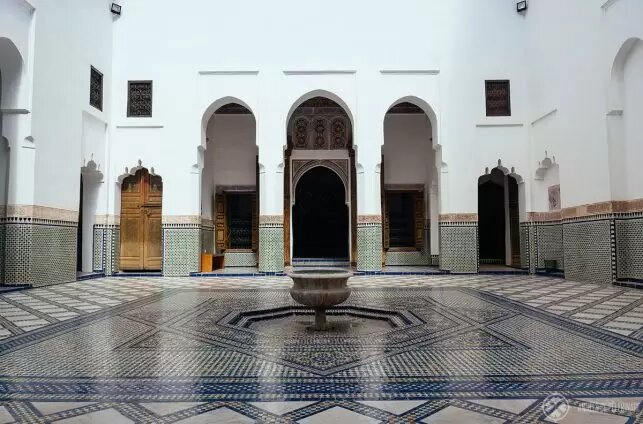
Dar Si Said is one of the city’s old museums that showcase Arab-Muslim art. Like most of the other buildings in the city, Dar Si Said was his personal home ,who was the minister of war under the regency of his brother Ahmed Ben Moussa, the vizier of Sultan Hassan I.
Built-in the second half of the 19th century, the house of Si Said is of Andalusian type. It is very vast and spreads out on more than 2 hectares and is divided into two floors. In 1932, under the French protectorate, the palace was transformed by the administration of fine arts into a museum, and since then, craftsmen go there to show their know-how.
In 1957, the house was divided into two parts, one for the museum and the other for crafts. Between 1978 and 1980, the house became a conservation and restoration center. The museum is now an exciting place, dedicated to tracing the production of carpets and weaving from all over the kingdom since the late 18th century and to highlight the work on wood.
The price for adults is 30 dh, for children over 12 years, it is 10 dh, and for children under 12 years, it is 5 dh. Fridays are free for nationals and foreign residents in Morocco, whereas, on Wednesdays, the visiting fee is free for foreign residents in Morocco and students who present a proof of identity.
9-Appreciate the Museum of Marrakech, One of the Most Beautiful Architectures
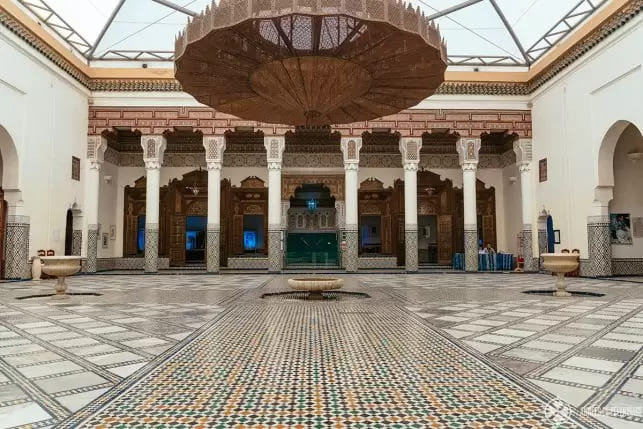
If you want to discover more about Moroccan culture as well as all kinds of traditional items such as jewelry, embroidery, ironwork, etc., you are at the right address.
Located only 50 meters from the Medersa Ben Youssef, the Marrakech Museum was once a palace. Towards the end of the 19th century, Mehdi Mnebhi, the former minister of defense of Sultan Moulay Abdelaziz, decided to build it for his personal residence.
The riad spreads over more than 2 hectares with about 700m² of the surface. Shortly before his death, Mehdi Mnebhi decided to bequeath his palace to his son-in-law Thami El Glaoui, who was at the time the Pasha of Marrakech.
Then, when Morocco got its independence in 1956, this magnificent private palace became a state property and was later transformed into a girls’ school (the first one in Morocco). Over time, the state of the palace deteriorated, and it was closed for several years.
In 1997, the palace was bought, restored, and transformed into a museum by Omar Benjelloun, a Moroccan businessman, a passionate and great collector of art, who subsequently made his private collection available to the public.
In this magnificent museum, there are the treasures of local crafts, a wealth of the city, and the country. There are archaeological and ethnographic objects, historical documents, and contemporary art.
On the first floor of the palace, there is an exhibition of jewelry, pottery, traditional weapons, clothing, costumes, carpets, and engravings of the time. On the second floor, there is an exhibition of precious wooden furniture. Different exhibitions and shows are organized in the patio, the hammam, or even in the kitchen of the palace.
The museum is known for its large courtyard as well as its gigantic chandelier and typical Hispanic-Moorish decor. The beauty of the place attracts many tourists. You can visit this magnificent museum any day of the week from 9 am to 6 pm. The entrance fee is 50 dirhams.
10- The Majorelle Garden:

After Jacques Majorelle, a French orientalist painter discovered Morocco in 1917, he fell in love with Marrakech city and decided to buy a large palm grove which became the Majorelle Garden in later years.
The Majorelle Garden, a small Art Deco studio painted in bright blue, is one of the most enchanting and mystical gardens in the country, inspired by Islamic Garden types. A botanical garden, spread over nearly a hectare with more than 300 exotic species brought back from his travels such as cacti, palm trees, bamboo, garden plants, aquatic plants, and other varieties of plants, all adorned with ceramic jars, ponds, and fountains.
At first, the garden was a source of inspiration for the painter Jacques Majorelle, but in 1947, this green space was opened to the public for the first time. After the death of the painter, unfortunately, the garden was abandoned. In 1966, Yves Saint Laurent and Pierre Bergé visited Morocco and fell under the charm of the city.
In 1980, they bought and renovated the garden that was to be destroyed to become a hotel complex and gave it the name “Villa Oasis”.
In the Majorelle Garden, you will find:
- The botanical garden is spread over 9000m2 and contains over 300 exotic species brought back during the painter’s travels.
- The Yves Saint Laurent Memorial
- The Berber Museum where you can discover ceremonial costumes, jewelry, and ornaments. This museum brings together a culture that spans 9 centuries.
- The bookstore
- The Love Gallery of Yves Saint Laurent, a building of 4000m2, opened and was inaugurated on October 19, 2017. It includes an exhibition room on the creations of Yves Saint Laurent and another dedicated to Jacques Majorelle, rooms for temporary exhibitions, an auditorium, a boutique and bookstore, a café-restaurant with a terrace, and a research library with 5000 books.
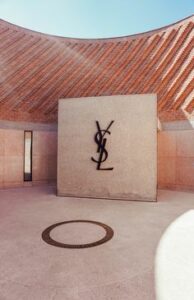
- The Majorelle boutique reflects Moroccan craftsmanship and at the same time pays tribute to Yves Saint Laurent through the colors of the products exposed.
- The Majorelle café.
To visit the Majorelle Garden, it is better to book your time slot through online ticketing on the website www.jardinmajorelle.com to avoid waiting in the queue. The place welcomes more than 600,000 visitors annually.
The Majorelle Garden is open every day from 8 am to 6:30 pm, and the last access is at 6 pm The Pierre Bergé Museum of Berber Arts is also open every day from 8 am to 6 pm, and the last access is at 5:30 pm. (Schedules may change during the month of Ramadan)
The ticket for the Majorelle Garden is 70 DH, that of the Berber Museum is 30 DH and for the Yves Saint Laurent Museum, the entrance is 100 DH, but if you want to visit the three museums at the same time you will only pay 180 DH per person. The entrance is free for children under 12 years old and students (with proof of age).
11-The Menara gardens: the oldest gardens in the West Muslim
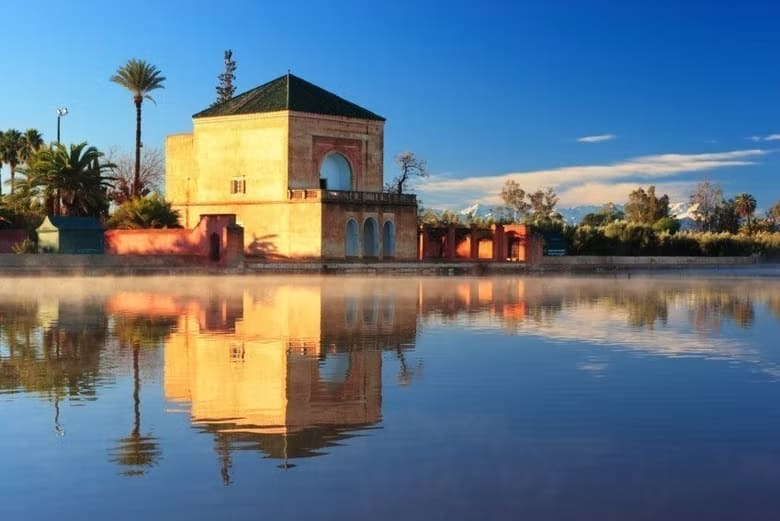
It is located in the west of Marrakech and is 30 minutes of walking from Jemaa El Fna square. The Menara is a park that dates from the 12th century (time of the Almohad dynasty) and which extends over more than 100 hectares.
Classified as a UNESCO World Heritage Site since 1985, the Menara gardens are composed of an olive grove, a huge basin, and a pavilion. The basin covers an area of 195m by 160m, it is shallow but serves as a water reservoir to feed the immense olive grove.
This feeding technique works thanks to a hydraulic system that dates back more than 700 years, and which consists of water from the source of the Atlas, which is located 30 km from the city, to the fields.
The beautiful pavilion of 144m2 was built in 1866 by the Alaouite Sultan Sidi Mohammad Ibn Abdallah.
The garden of the Menara is pleasant for walks, it is a meeting place for Moroccan families. The entrance is free all week from 9 am to 5 pm, but to visit the pavilion, you have to pay to visit the pavilion, you have to pay 75 DH per person.
12- The Palmeraie:
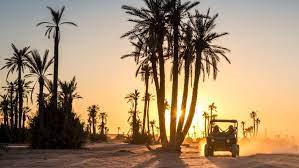
Located outside the city and dating from the time of the Almoravid dynasty, the palm grove is a real oasis of greenery in the middle of the desert with more than 100 000 palm trees over an area of 15,000 hectares, in addition to a vegetable garden and a production of dates.
It is a lush nature, ultramodern, which makes it a tourist natural heritage. It has become the most luxurious area of Marrakech. To walk in the Palmeraie, you can opt for a camel, a carriage, a quad, or even on foot. The camel ride remains the most touristic option to peacefully admire the beauty of the Palmeraie.
The corners to visit absolutely!
- The Jemaa El Fna square

Dating from the 11th century, this wonderful square is the tourist heart of Marrakech, it is the liveliest place in the city and attracts more and more visitors. This open-air theater where you can find all kinds of animations is especially not to be missed.
- The Souks
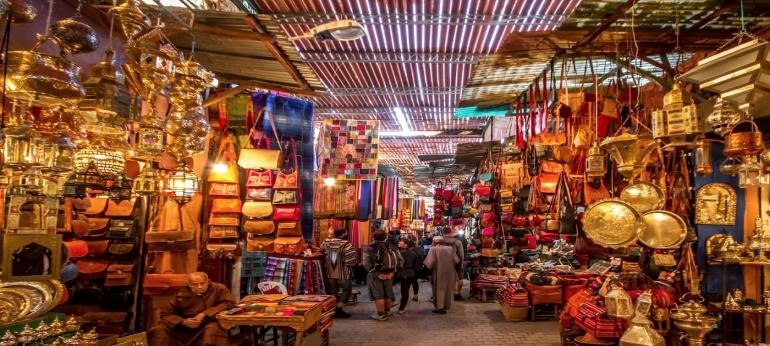
The souks of Marrakech are unavoidable; We are in front of a living exhibition of Moroccan handicrafts, and we find everything, babouches, jewelry, clothing, carpets, spices, pottery… the atmosphere of the haggling is just magnificent.
- The Koutoubia Mosque

Built-in 1141 by the Almoravids and located only 300m from the Jemaa El Fna square, the mosque Koutoubia imposes itself with its minaret of 77m, it is one of the most important mosques of Marrakech because it is the symbol of the city par excellence.
- The palm grove:
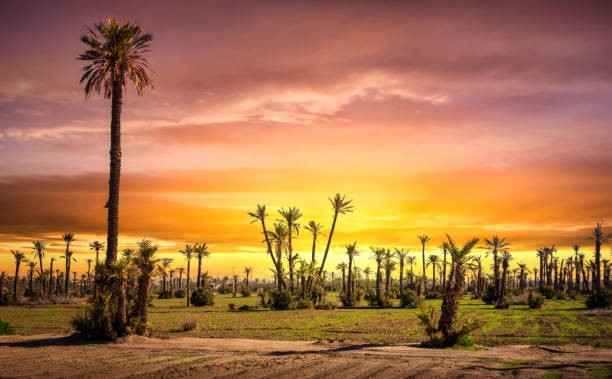
Dating from the time of the Almoravid dynasty, the palm grove is one of the most luxurious areas of Marrakech. It is a real oasis of greenery.
- The Ben Youssef Medrassa

The Ben Youssef Medrassa is an old Koranic school built in the 14th century by the Marinids and rebuilt and the Marinids and rebuilt and enlarged in the middle of the 16th century by the Saadians. It is the largest Koranic school in Morocco and North Africa.
Since the Ben Youssef Medersa was transformed into a museum, it has become one of the most visited and admired cities of Marrakech, its Moorish architecture leaves the tourists speechless.
Price: Adults 65 DH / children 30 DH
Address: rue Assouel, Marrakech
Schedule: open Monday to Sunday from 9 am to 6 pm
- The Majorelle Garden
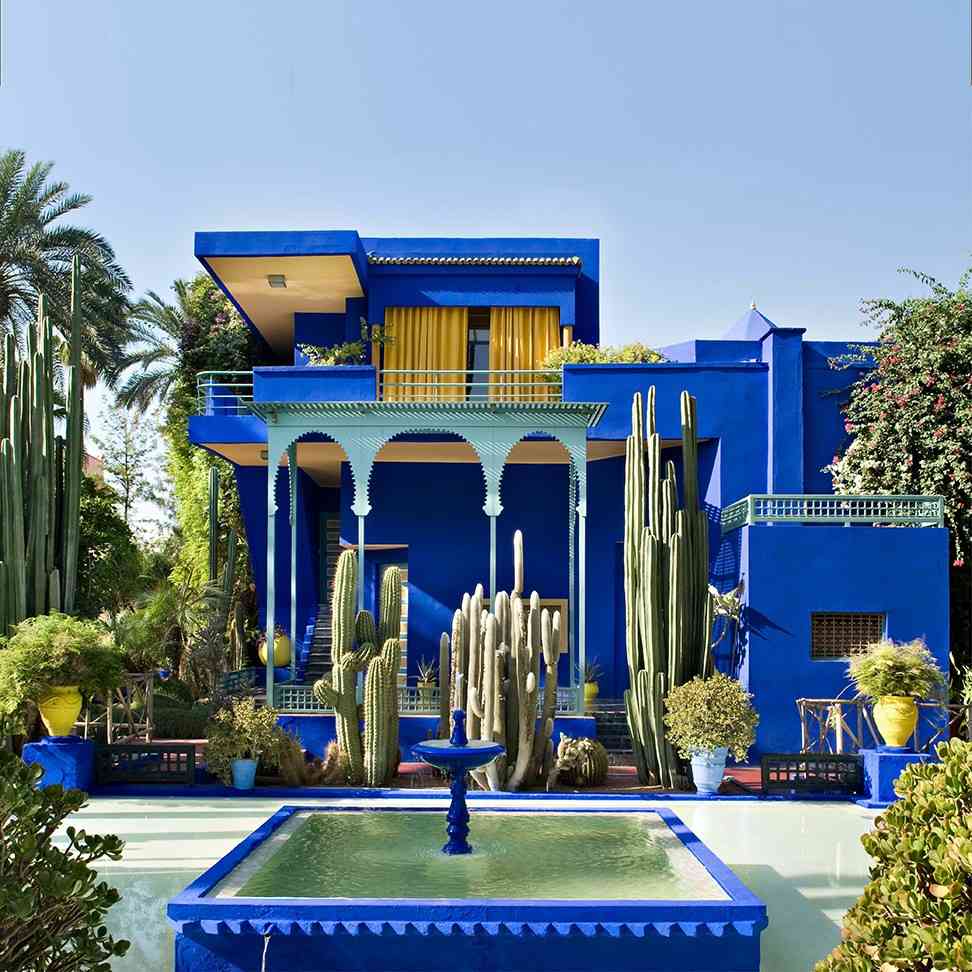
The Majorelle Garden, a small Art Deco workshop painted in bright blue, is one of the most enchanting and mystical gardens in the country, inspired by the types of Islamic gardens created by Jacques Majorelle in 1922.
In 1980, the Majorelle Garden was purchased and renovated by Yves Saint Laurent and Pierre Bergé. The garden of nearly one hectare consists of the botanical garden of 9000m2, the Memorial Yves Saint Laurent, the Berber Museum, the bookstore, the Love Gallery of Yves Saint Laurent, the Majorelle boutique, the Majorelle café, the Yves Saint Laurent Museum, a building of 4000m2.
Its colors, beauty, and rich craftsmanship attract more and more tourists, moreover, the place welcomes more than 600 000 visitors annually.
- Price: The Majorelle Garden: 70 DH / The Berber Museum: 30 DH / The Yves Saint Laurent Museum: 100 DH / Combined ticket: 180 DH. There is a free entrance for children under 12 and students (with proof).
- Address: Rue Yves St Laurent, Marrakech 40090
- Schedule: The Majorelle Garden: Monday to Sunday from 8 am to 6:30 pm, the last access is at 18h.
- The Pierre Bergé Museum of Berber Arts: Monday to Sunday from 8 am to 6 pm, the last access is at 5:30 pm.
- The Yves Saint Laurent Museum: open every day except Wednesday from 10 am to 6 pm, the last access is at 5:30 pm.
- Schedules may change during the month of Ramadan.
- The museum of Marrakech
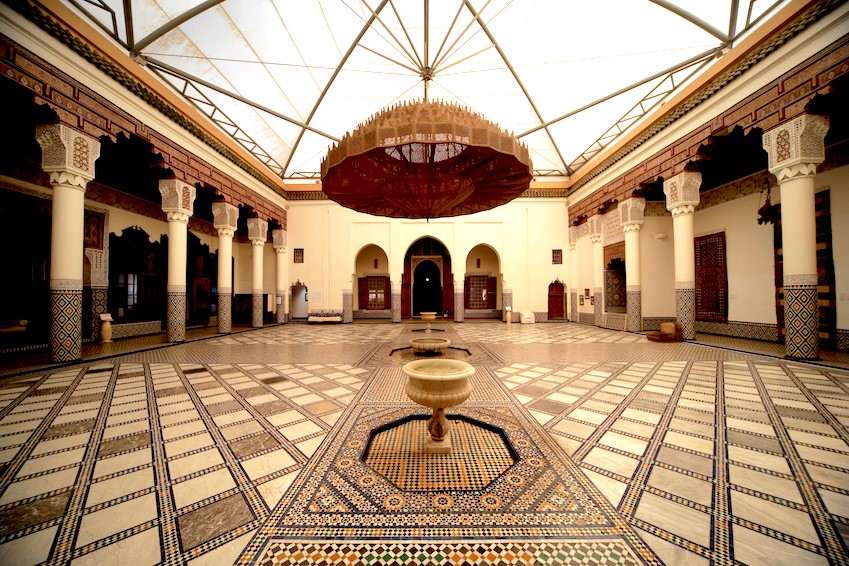
Located only 50 meters from the Medersa Ben Youssef, the museum of Marrakech was formerly a palace.
Towards the end of the 19th century, Mehdi Mnebhi the former minister of defense of Sultan Moulay Abdelaziz decided to build it for his dwelling. The Riad spreads over more than 2 hectares with about 700m² of the surface.
In 1997, Omar Benjelloun, a well-known Moroccan businessman, passionate and great art collector, bought, restored, and transformed the Riad which spreads over more than 2 hectares with about 700m ² of surface in a magnificent museum where one finds objects archaeological, ethnographic, historical documents, and contemporary art.
- Price: 50 DH
- Schedule: open Monday to Sunday from 9 am to 6 pm
- The Bahia Palace
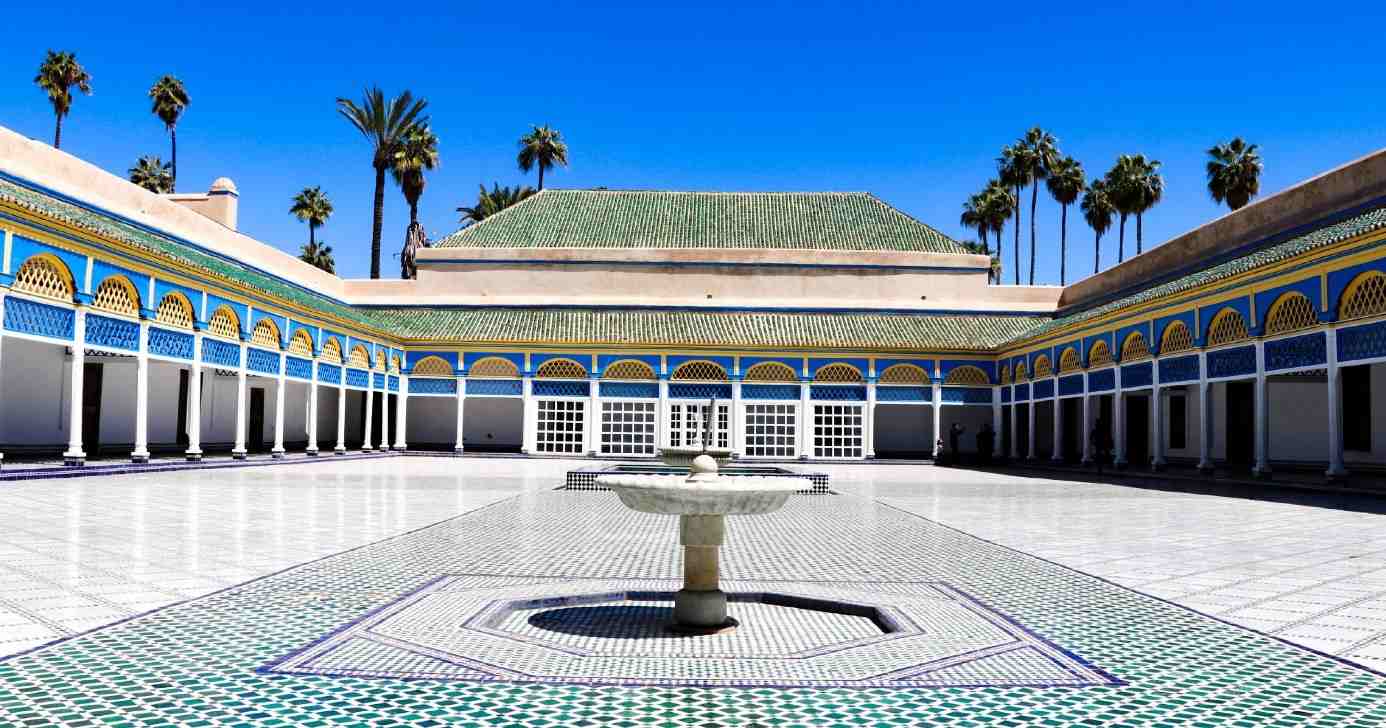
Listed as a World Heritage Site by UNESCO, the Bahia Palace is one of the most beautiful palaces in the world. It is one of the most beautiful palaces, with ceilings of notched cedar, its plaster, its Zellige, and its marble shining will take your breath away. It is one of the most visited palaces in Marrakech.
The Riad was built in the late 19th century by Si Moussa, the vizier of Sultan Hassan I, to honor his wife named La Bahia. The 8-hectare palace has passed through several hands until part of it became accessible to visitors today.
- Price : 70dh
- Address: Rue Riad Zitoun el Jdid, Marrakech 40000
- Schedule: open from Monday to Sunday from 9 am to 5 pm
Marrakech is more than just a culture
Morocco has passed under several dynasties which makes it has a culture and a very rich culture and crafts.
Berber craftsmanship has been inherited, and the know-how has been passed on from one generation to another with love and passion.
This craft was represented through objects useful to the such as jewelry, carpets, ceramics and pottery, wrought iron, marquetry and cedar, plaster and Zellige, brassware, tanning, leather and leather goods, traditional clothing, etc.
- Handicrafts:
Jewelry
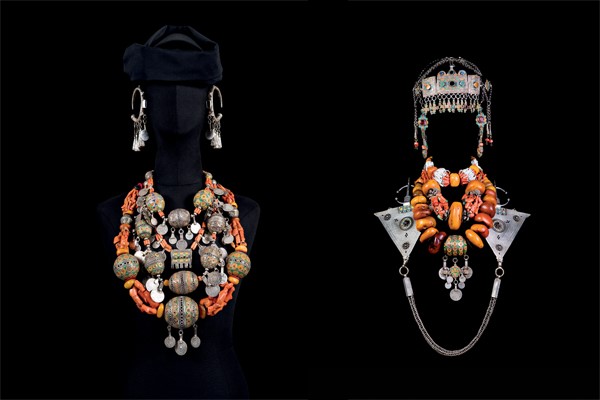
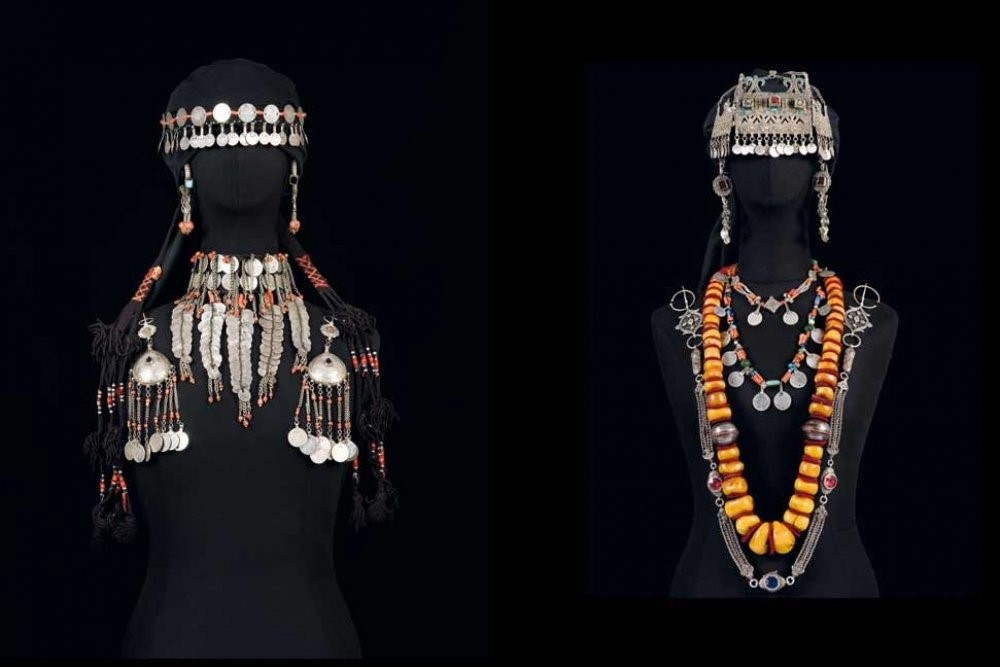
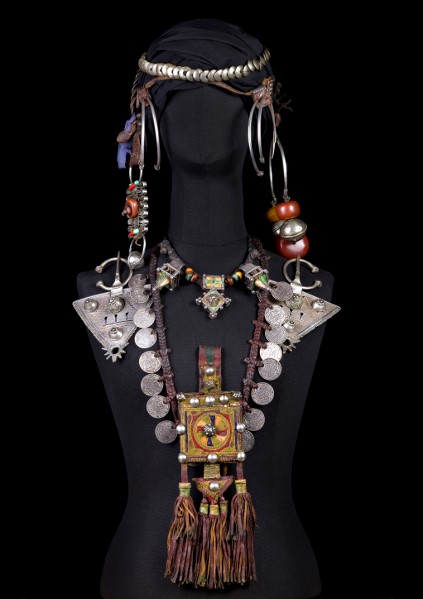
The carpets
Berber carpet Beni Ouarain handmade zigzag pattern
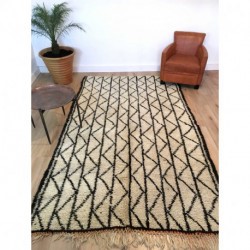
Berber carpet Beni Ouarain beige and black with geometric patterns
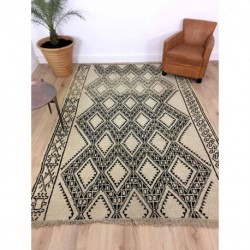
Berber carpet Beni Ouarain thick wool beige, brown, and orange
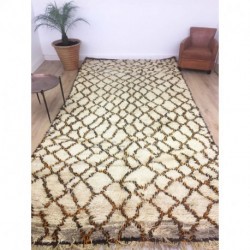
Berber carpet Beni Ouarain white, gray, and brown
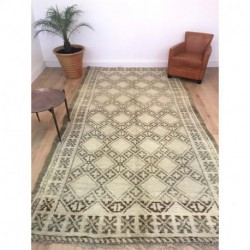
Berber carpet Boujad red and green ethnic patterns
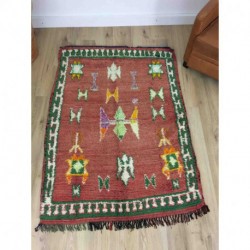
Berber carpet Boujad colored
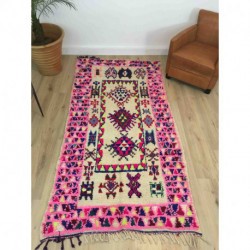
Berber carpet Boujad old brown orange primitive patterns
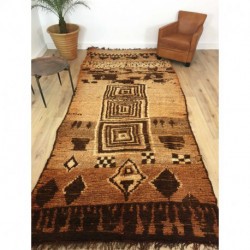
Berber carpet Boujad old bright color
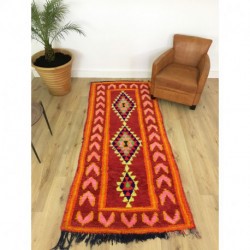
Berber carpet Boucherouite patchwork style
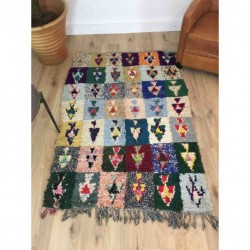
Berber carpet Boucherouite with black background
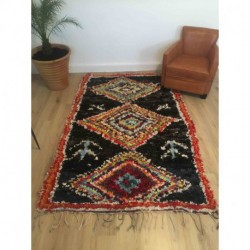
Berber carpet Beni M’Guild green
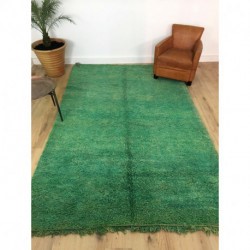
Berber carpet Beni M’Guild old dense wool and silky
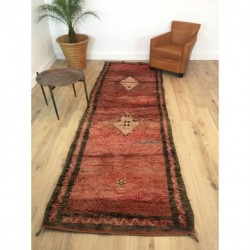
Ceramic and pottery
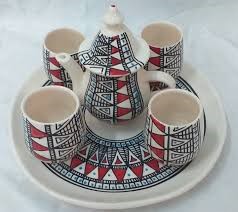
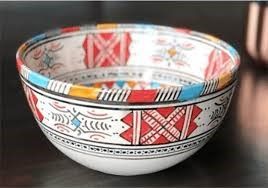
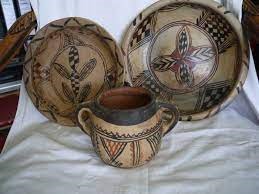

Wrought iron
Wrought iron window

Lantern in wrought iron
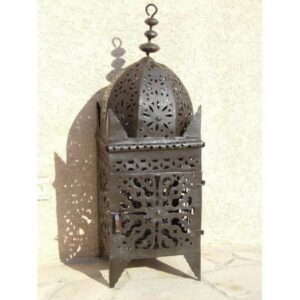
The marquetry and the Thuya

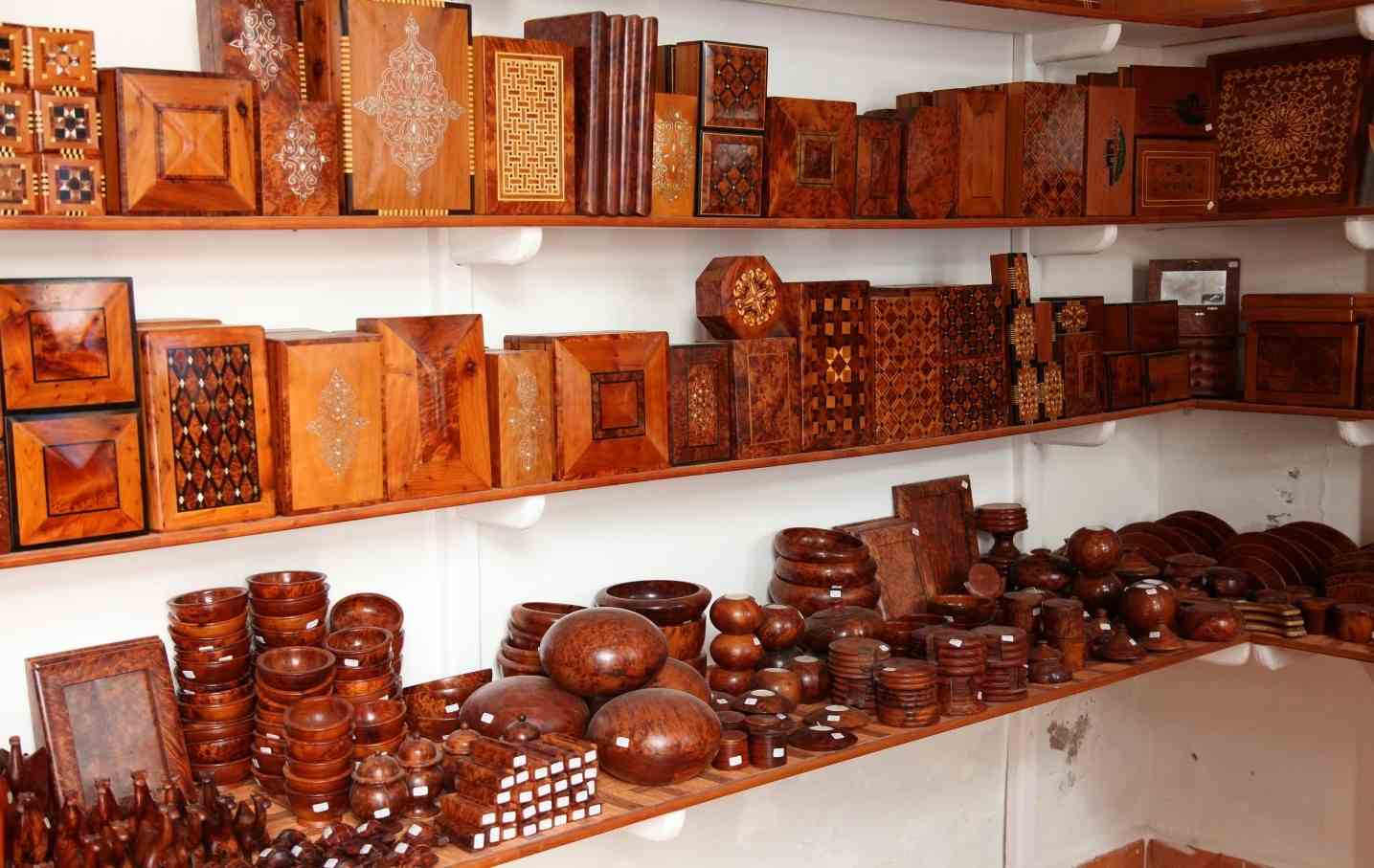
Plaster and Zellige
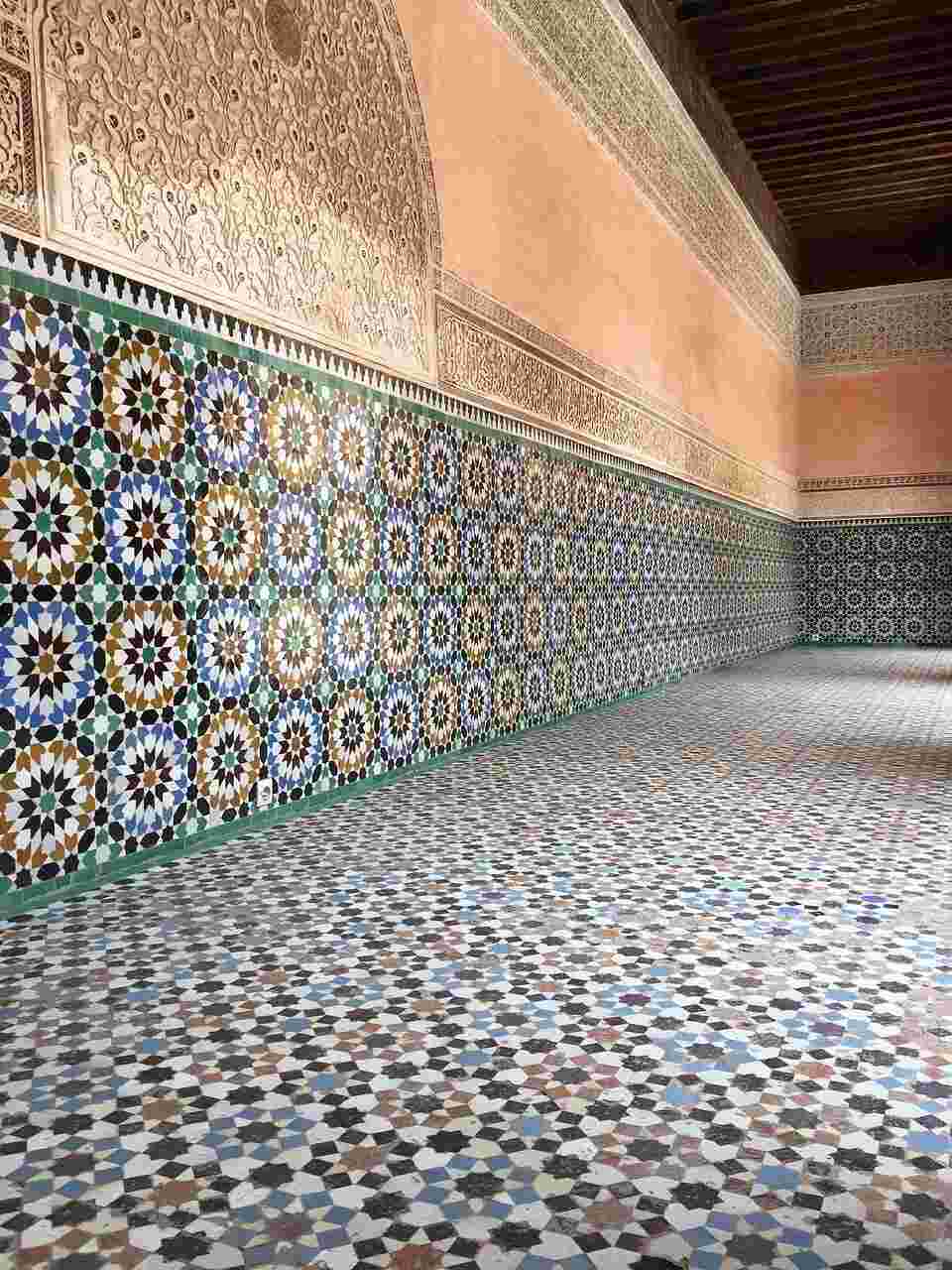
The brassware
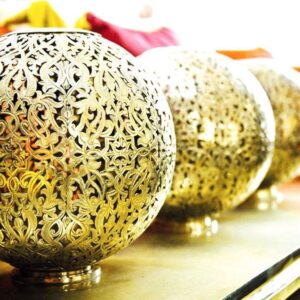
Tannery, leather, and leather goods

Traditional clothing
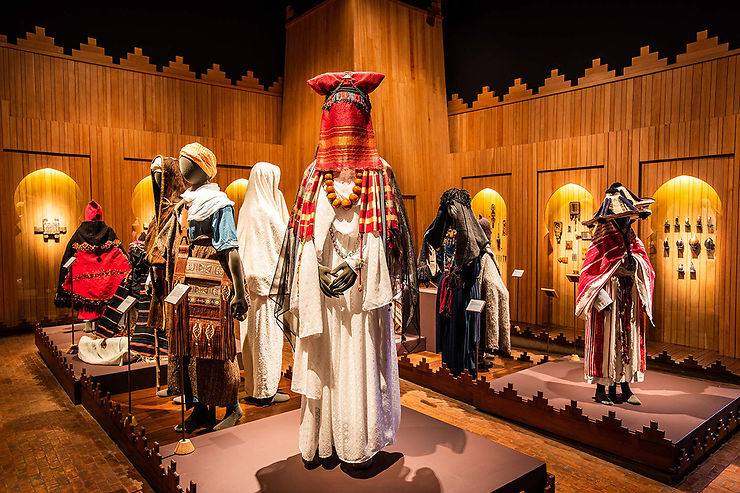
- Arts :
The great writers of Marrakech:
Mahi Binebine (1959)
My Seddik Rabbaj
Mohamed Sebti
Juan Goytisolo (1931- 2017)
Elsa Nagel
Thérèse Zrihen-Dvir (1945)
Marrakesh poetry
Every year the city of Marrakech organizes an event called “Le Printemps de La poésie » which takes place in several places of the city such as the place Jemaa El Fna, the university as well as the cultural center Dar Charifa, to show the various talents of which the city has.
This event gives rise to several cultural and artistic activities such as animations for young and old, reading sessions, exhibitions, film screenings, workshops, etc.
Painting in Marrakech
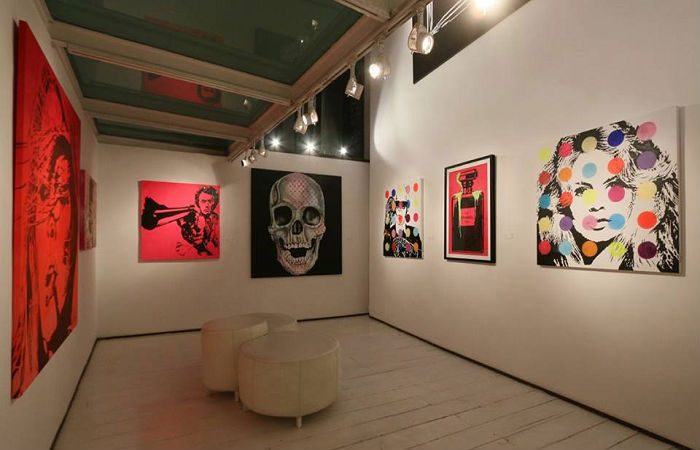
Marrakech is one of the cities which benefits from a very important cultural wealth. The city knows a great number of museums as well as art galleries that put forward as well Moroccan artists and painters as well as European, African, or contemporary art.
Among the art galleries in Marrakech are:
– BCK Art Gallery / Address: 62, Rue de Yougoslavie 40000, Marrakech
– Gallery 127 / Address: 127, Avenue Mohammed V 40000, Marrakech
– Gallery Design & Co by Bruno / Address: 166 Bis, Sidi Ghanem Route de Safi 40000,
– Matisse Art Gallery/ Address: 61, rue Yougoslavie n°43, Passage Ghandouri Gueliz 40000, Marrakech
– Jardin Rouge / Address: KM 20, Route de Fès, Jnane Lhamare Ouidane Douar Ouled Zbir 40000, Marrakech
– Galerie noir sur blanc / 48, Rue Yougoslavie 40000, Marrakech.
– Dar Bellarj Foundation / 9, Rue Taoualat Zaouiat Lahdar 40000, Marrakech
– David Bloch Gallery / 8 Bis, Rue des Vieux Marrakchis 40000, Marrakech
The architecture
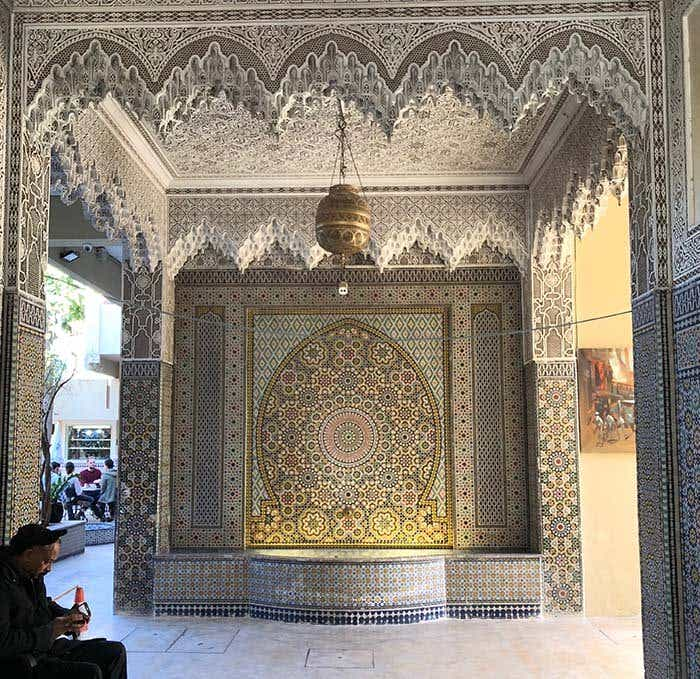
Marrakech was taken in 1062 by the Berber dynasty of the Almoravids who were very influenced by Andalusia. Thereafter, Morocco was influenced by neighboring countries.
For example, the Berber dynasty of the Almoravids was very influenced by Andalusia. The degree of influence was shown through the architecture of the Koutoubia Mosque which is an inspiration for the Mosque of the Giralda in Seville, Andalusia.
The Berber style can be seen in the El Badi Palace, the Arab-Andalusian style in the Ben Youssef Medersa, and through the Ben Youssef Medersa, the Bahia Palace, the Dar Si Said Museum and the colonial architecture following the French influence which is shown through the Yves Saint Laurent Museum.
It is thanks to this architectural wealth that Marrakech is today one of the most touristic cities in Morocco.
The music
Berber music
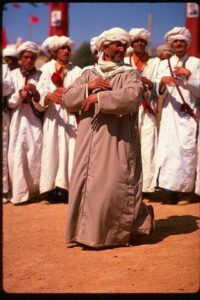
The first people who ruled Morocco were Berbers. Berber music is the oldest and most original musical style, it varies according to the region and it is generally accompanied by traditional musical instruments such as the rebab, a kind of hurdy-gurdy, or the Loutar which is of the family of the oud (lute).
The song is always accompanied by dances where women and men make rhythmic gestures with their arms and their feet with their arms and feet with foot beats that adapt to the music.
Andalusian music / The Mouwal
This music was imported by the Arabs expelled from Spain and came to the cities of northern Morocco. Andalusian music is a music of the elite, often reserved for the celebrations of notables where musicians wear white djellabas, accompanied by several knobs, kinds of instrumental and vocal suites.
It is inspired by the songs of religious poems; it includes individual and/or collective songs which are Inchad and Mouwal
The Chgouri (Judeo-Moroccan music)
The chgouri dates from the 1920s, it is a style of Judeo-Arabic music very little known in Morocco, especially by young people. It is a composition of the San’aa, a style of music Arabo- Andalous Gharnati music and chaabi music.
The chaabi
Chaabi is the most popular music genre in the country, known by the majority of Moroccans. There are two types of cabin-malhounchaabi-malhoun and the modern cabin which dates from the 1980s.
Moroccan rap
Moroccan rap is a style of music inherited from rap and hip-hop culture. The term Hayha means “to have fun.” It dates from the 1980s, Arab-Moroccan rap is the only Maghrebian and Arab-Muslim rap that is present in the Arab media.
The gastronomy of Marrakech
- By regions:
Moroccan gastronomy is very well known for its diverse and rich traditional dishes. Each region is known by its specialty.
- The specialty of Ourika – The tagline of lamb and vegetables, the traditional couscous with vegetables and caramelized onions, Moroccan Harira with tomato and chickpeas.

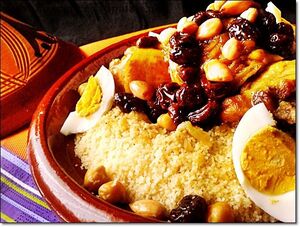
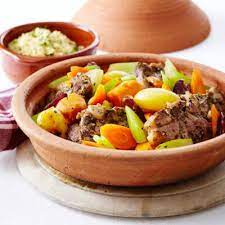
- The specialty of Marrakech – The Tanjia, the Berber couscous, and the chicken tagine with olives.
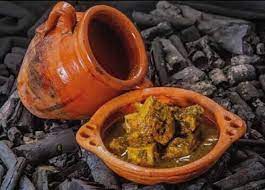
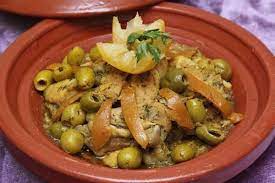
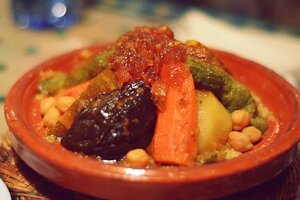
- The specialty of Safi – Orange salad with black olives, grilled sardines, melting meringue with nuts, and couscous.
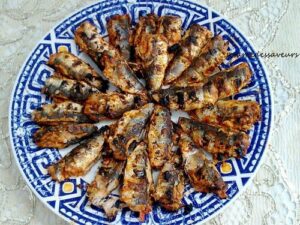
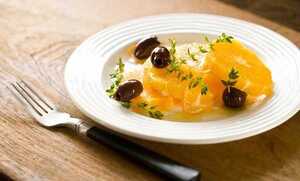
- The specialty of Essaouira – Harira, grilled fish, traditional pastilla, and Tanjia.
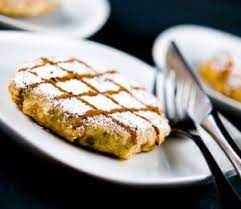
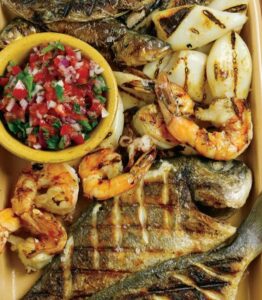

- Our top 10 best restaurant selections:
The 10 best restaurants in Marrakech:
LA MAISON ARABE : Budget from 30 to 60€.
- Cuisine specialties: French, African, Moroccan, Mediterranean, Middle Eastern, International.
- Address: 1 Derb Esseh bab Doukkala, Medina.
- Phone: +212 524 424 242.
DAR MOHA MARRAKECH : Budget 16 to 60 €.
- Cuisine specialties: Moroccan, Middle East
- ADDRESS: 81, Rue Dar El Bacha, Medina, Marrakech
- Schedule: Monday is closed the other days is open from 12:00 to 23:00
- PHONE: 05.24.38.64.00
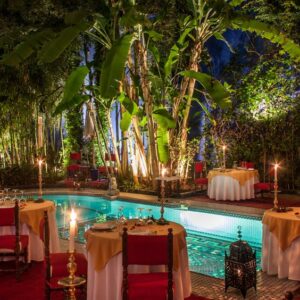
BO ZIN MARRAKECH : budget from 40 to 100€.
- Specialty cuisines: European, Asian, Thai, Healthy, International
- ADDRESS: Route de l’Ourika 3,5 KM Douar lahna, Marrakech +5,7 KM of the Mosque and Minaret of Koutoubia
- Opening hours: open from 20h00 to 04h00 in the morning
- PHONE: 05.24.38.80.12
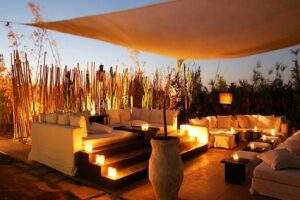
RESTAURANTS in AGAFAY
THE WHITE CAMEL LODGE : Budget 77€.
- ADDRESS: Commune of Agafay, THE WHITE CAMEL, Lodge, Marrakech
- Opening hours: open 24/24 H
- TEL: 06.60.38.97.56

THE PEARL CAMP : budget 56€.
- Specialty cuisines: Asian, Mediterranean
- ADDRESS:AV Echouhada and Rue du Temple, Hivernage ,Marrakech
- TEL:05.24.42.42.42
Restaurants of the Atlas :
LE FLOUKA : Budget 56€.
- Specialty cuisines: Moroccan, Middle Eastern.
- Address: LE FLOUKA, BP 45 Barrage Lalla Takerkoust.
- Phone: +212 664 926 260.
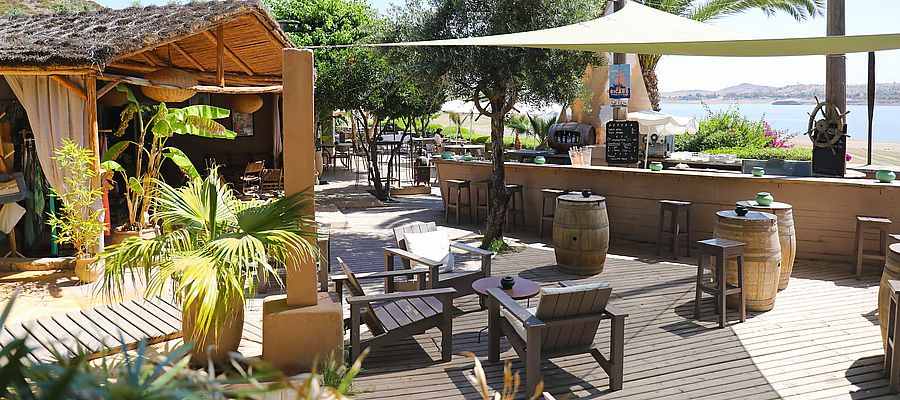
The Terrace, Restaurant, and Lounge Atlas Golf Marrakech: Budget 70€.
- Specialties: Moroccan, Middle Eastern, European.
- Services available: Meals on site and take away.
- Opening hours: 08:00 – 13:00.
- Address: Atlas Golf Marrakech, km 1 Route d’Amizmiz.
- Phone: +212 524 376 666.
Restaurant of the Medina :
Dar Essalam : Budget 38€.
- Specialty cuisines: Moroccan, Middle Eastern.
- Services available: Meals on-site drive available, delivery without contact.
- Opening hours: Open every day of the week from 11:45 to 23:00.
- Address: 170 Riad Zitoun Kedim, Marrakech.
- Phone: +212 524 443 520.

THE GARDENS OF THE MEDINA : budget from 9 to 60€.
- Specialty cuisine: Moroccan and Middle Eastern
- Opening hours: Open for lunch and dinner, 7 days a week
- Address: 21, Derb Chtouka, Kasbah, Marrakech
- Tel: +212 524-381-851
DAR YACOUT : budget 79,00€
- Specialty cuisine: Moroccan gastronomy
- Opening hours: Closed for lunch and on Mondays, open for dinner Tuesday-Sunday
- Address: 79, Derb Sidi Ahmed Soussi, Bab Doukkala, Marrakech
- Tel: +212 524-382-929
Atlas Golf Marrakech, km1 Route d’Amizmiz
- Agriculture:
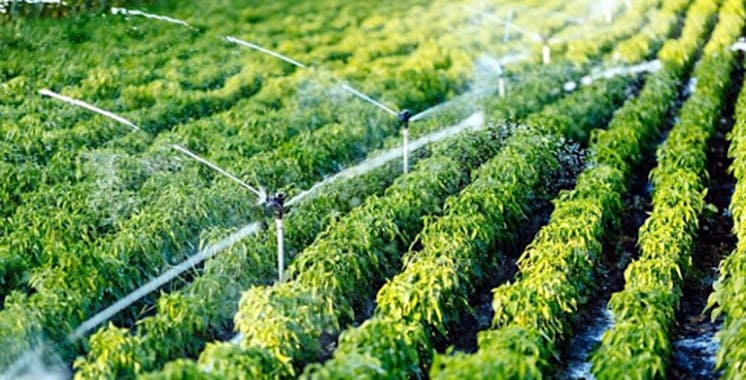
The agricultural area of the Marrakech-Safi region covers two million hectares, highlighting the importance of agriculture as a pillar of the region’s economy, contributing 15% to the regional GDP.
Local products of Marrakech:
Marrakech is known for local products such as argan, olive oil Tyout Chiadma, Raison Doukkali, Walnut of the Atlas, Almond of Haha, Honey of Haha, Azembou, Fennel, Marrakech lime, Alouidane okra, Iris, Ghmat verbena, Felliouia mint, Reason of Chiadma, Pomegranate Skhour, Cumin Beldi, Caper of Safi, and more.
Fruits and vegetables of Marrakech:
The region of Marrakech produces a variety of fruits and vegetables, including potatoes, onions, tomatoes, carrots, pumpkin, lemon, melon, table grapes, apricots, and more.
- Economy:
- Due to the impact of Covid-19, the region of Marrakech is undergoing improvements in several areas to enhance the economic attractiveness of the city.
- At the tourist level, efforts are being made to enhance the medina circuits, specifically the circuit from Bab Taghazout to Diour Saboun.
- Work is underway to develop the tracks of the following municipalities: Loudaya, Harbil, Ait lmour, Ouahat Sidi Brahim, and Saada.
- The development of the technology park of Tamansourt, covering an area of 40 hectares, has been launched.
5 essential tips to remember before departure:
- Choose to travel to Marrakech in autumn or spring rather than in summer or winter.
- Morocco is a conservative country, so it is important to dress modestly and be respectful, especially during the month of Ramadan.
- Find out about Moroccan holidays.
- Always negotiate prices and think of paying in dirhams, as it is much cheaper.
- Avoid walking around with valuables to avoid being robbed.
Our selection of tourist activities:
- Going out in the evening:
Marrakech is a very lively city in the evening. It is known for the Jemaa El Fna square, which never sleeps, and for its many restaurants, cafes, bars, discos, and pubs. Whether with family, friends, couples, or alone, you will never be bored in Marrakech. You can enjoy your evening either at the Jemaa El Fna Square or in the Gueliz district, where there is a wide range of restaurants and bars that you will surely love.
We propose some addresses that you will surely love:
Comptoir Darna: a chic restaurant that offers dinner with shows, belly dancers, and musicians.
- Address: Avenue Echouhada, Marrakech 40000
- Opening hours: Opens at 19:00
- Phone: +212 524-437702
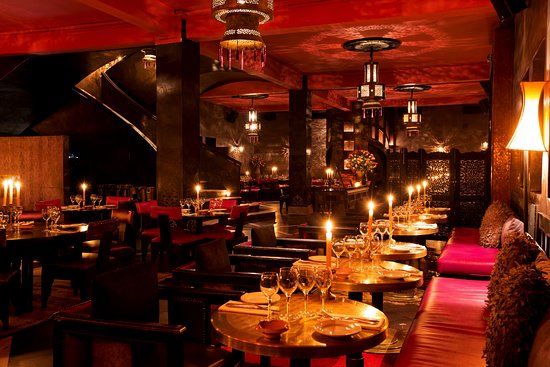
Dar Soukkar : the best restaurant with three cuisines (Asian, Mediterranean, and Moroccan), perfect for group dinners, and offers shows with dancers and musicians.
- Address: Nouvelle Zone Touristique – Route de l’Ourika – Km 3,5، 40000
- Opening hours: Opens at 19:00
- Phone: +212 524-375535
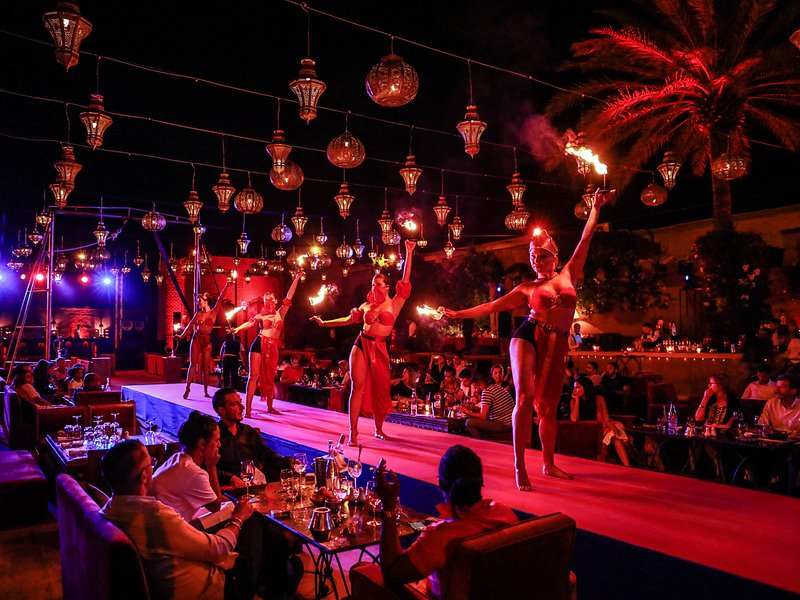
So Lounge Marrakech : a modern bar in the heart of the most beautiful and luxurious hotel gardens.
- Address: Rue Haroun Errachid, Marrakech 40000
- Opening hours: Opens at 19:00
- Phone: +212 656-515009
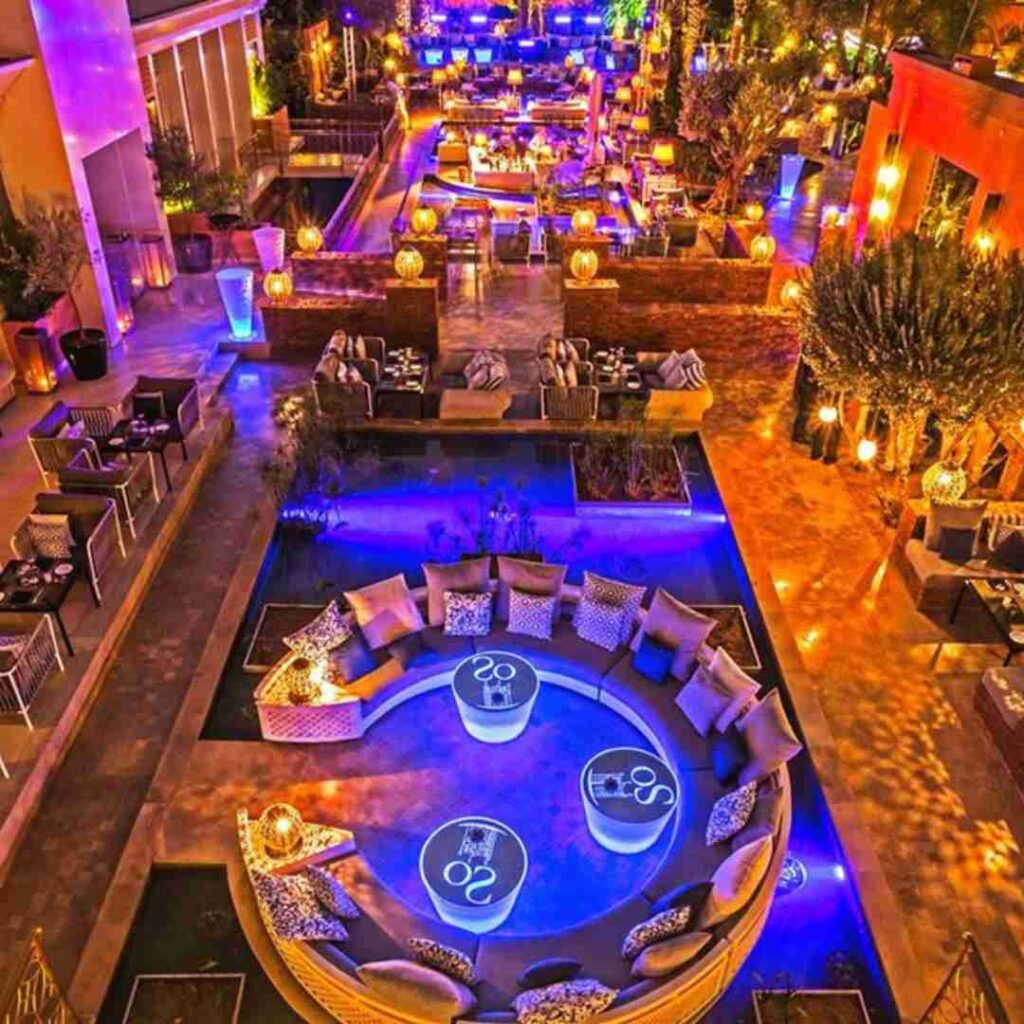
Epicurien : located in the heart of the casino, known for its refined and creative cuisine, cocktails, and exceptional concerts. Reservation required.
- Address: Rue Ibrahim El Mazini Es Saadi Marrakech Resort، 40000
- Opening hours: Opens at 20:00
- Phone: +212 663-055704
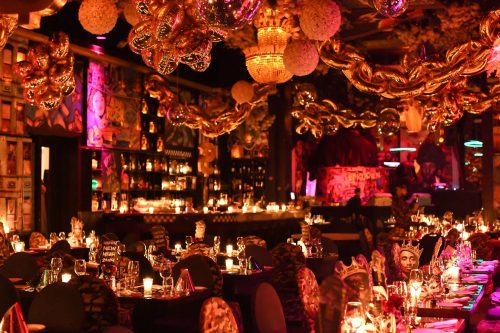
The Blokk : A quality restaurant that offers live musical performances.
- Address: Circuit De La Palmeraie, Farah Property, Prefecture, Marrakech 40000
- Opening hours: Opens at 20:00
- Phone: 0674-334334
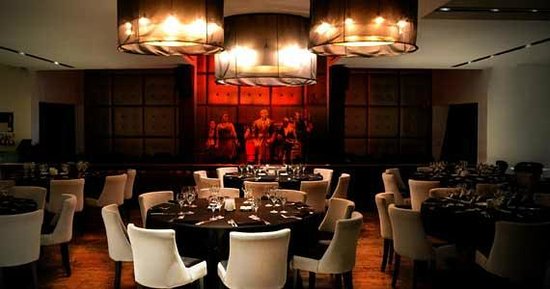
Theatro Marrakech : The best discotheque in Africa since 2003.
- Address: Rue Ibrahim El Mazini, Casino de Marrakech Es Saadi Marrakech Resort، 40000
- Schedule: Opens at 23:30
- Phone: 0664-860339
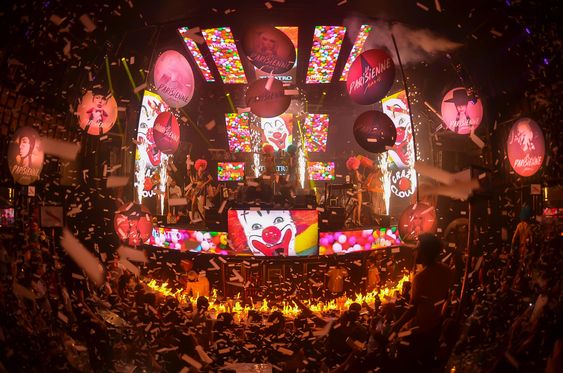
Explore the surroundings of Marrakech:
- Excursion to the Atlas Mountains to discover the Ouzoud waterfalls
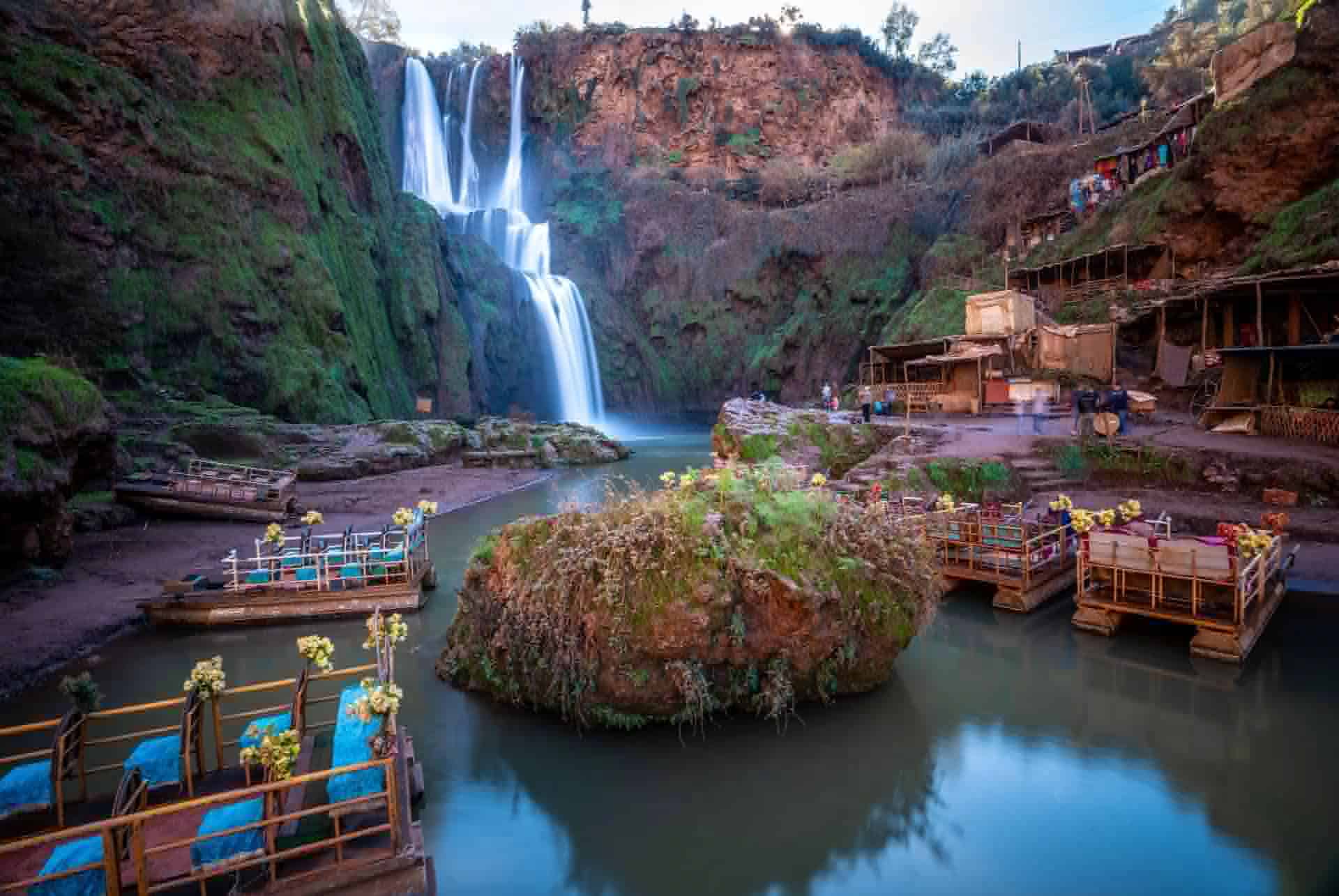
If you love nature and the sound of water trickling down, the Ouzoud Waterfalls in Ouzoud are the best destination. The most beautiful and highest waterfalls in Morocco are located 150km from Marrakech. This place is really impressive, and you can bathe at the foot of the waterfall and enjoy a delicious tajine with a glass of mint tea.
The excursion to the waterfalls of Ouzoud costs about 20 to 25€ per person (negotiate the price, especially if you are numerous).
- Discover the Agafay desert
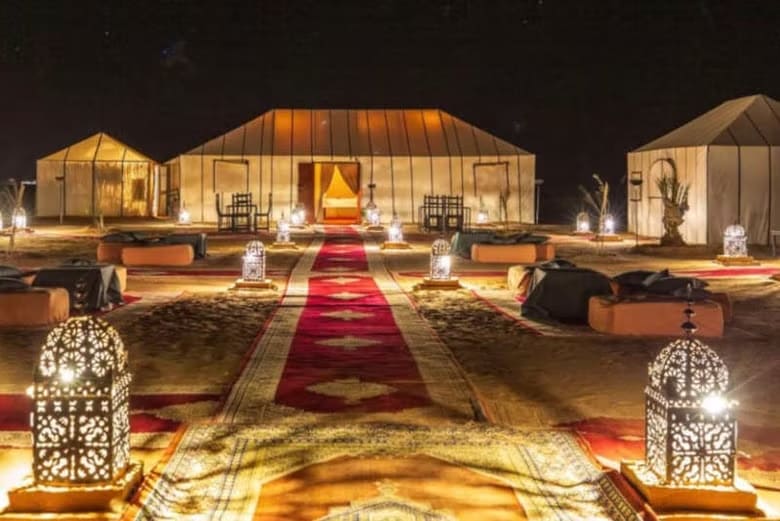
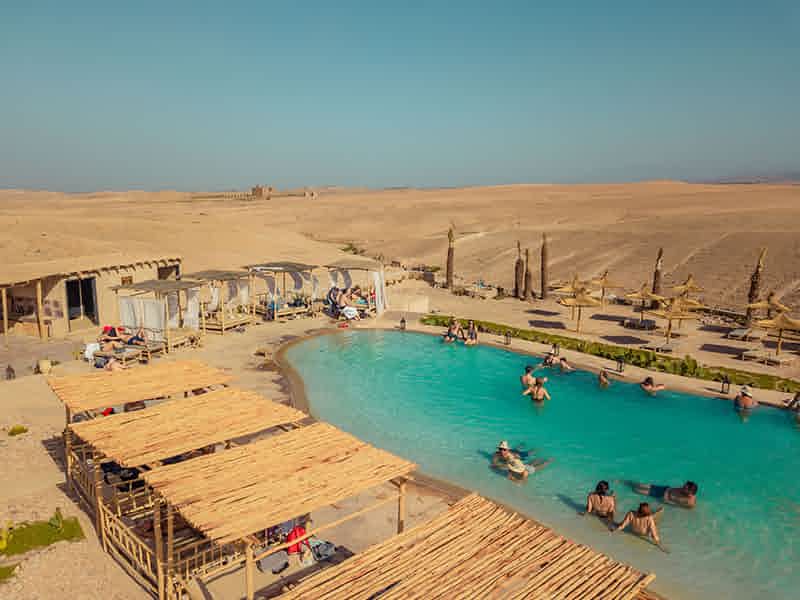
Less than an hour south of Marrakech is a beautiful desert, that of Agafay, a surprising desert not of sand, but a small natural jewel, a desert area between Marrakech and the Atlas Mountains. To take advantage of these beautiful landscapes, it is better to devote half a day to a quad excursion.
The half-day quad tour with transfer costs about 90€ per person. (It is necessary to negotiate the price, especially if you are numerous).
-The Berber villages of the High Atlas
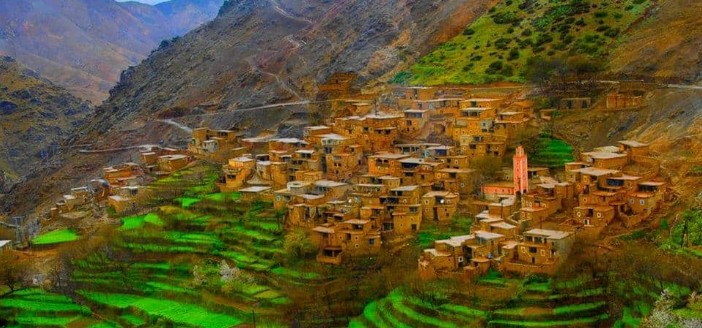
If you like the freshness of the mountains, in less than an hour from Marrakech, the Berber villages of the High Atlas will make you live a new experience, different from what you have seen, as well as a rather simple way of life. The villages of the High Atlas will allow you to breathe fresh air while enjoying the beautiful landscape.
The day trip to the High Atlas villages costs between 30 and 40€ per person. It is necessary to negotiate the price, especially if you are numerous.
-Hot air balloon flight around Marrakech
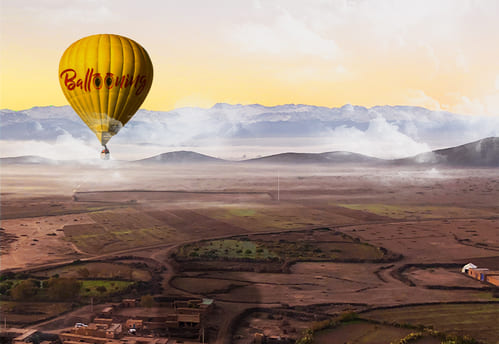
If your length of stay and, especially your budget allows it, it would be great to experience a hot air balloon flight. This flight costs around 200€ and is usually done at sunrise.
During the flight, you will have the opportunity to admire the Atlas Mountains, the Berber villages, and the red city.
-Sleeping in the desert of Marrakech
If your time and budget allow, opt for the Moroccan Sahara Desert, the largest desert in the world. The two most important areas of this desert are Zagora and Merzouga.
Zagora is located 360km from Marrakech and takes about 7 hours to reach with stops. It is the closest to Marrakech and has fewer dunes than Merzouga. 2 days and one night with pick up from Marrakech to Zagora cost about 80 to 90 € per person. (It is necessary to negotiate the price, especially if you are numerous).
On the other hand, Merzouga is 550km from Marrakech, about 10 hours of travel with stops. The desert of Merzouga is the most impressive desert and the most visited by tourists. The sand dunes of the Erg Chebbi region, which is located south of Merzouga, reach up to 150 meters
- Horseback riding in Essaouira
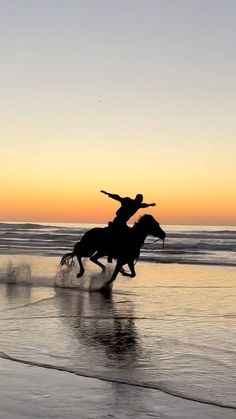
If you have time to spare, consider spending a day or two in Essaouira to discover the city, eat fresh fish and even go for a horseback ride.
The city is located on the Atlantic coast only 170km from Marrakech, a two-and-a-half-hour drive. You can go by rental car, with your guide or even by bus. The best way to visit the city in one day is with a guide.
Excursions to Essaouira generally start at 23€ and can go up to 30€ depending on the season and the size of the group.
Once there, you will fall under the spell of the blue and white colors of the streets of the medina, you will have the opportunity to discover the Place Moulay El Hassan which is considered the heart of the city, the Skala wall, one of the settings of the Game of Thrones series, then the port and the beach of the city where you can make at the end of the day an hour of horseback riding at the end of the day at the Diabat Ranch, the ideal place to practice horseback riding at only 16€ per person.
It is necessary to negotiate the price and to foresee long pants and closed shoes and closed shoes for horseback riding.
Camel adventures:
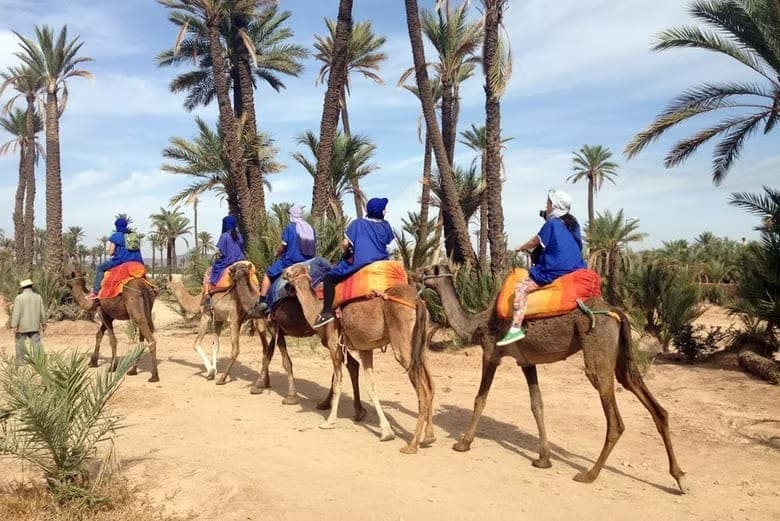
Whether in the Palmeraie, 15 minutes from the center of Marrakech, in the desert of Agafay in the desert of Zagoura, or even in Merzouga, the camel rides remain among the best experiences to live in southern Morocco, they allow you to admire the beauty of the desert and the sand dunes.
Camel rides can cost from 20 to 35€/hour depending on the region and the season.
The 10 best discoveries of Marrakech
1- Stay in a Riad
2- Eat outdoors at the Jemaa El Fna square
3- Try the Hammam
4- Take a hot air balloon ride
5- Spend two or three nights in Merzouga
6- Relax your mind in the Menara gardens
7- Get lost in the alleys of the Medina
8- Explore the Agafay desert on a quad bike
9- Ride a horse-drawn carriage
10- Camel ride
Marrakech for sports lovers
Sports lovers will enjoy Marrakech
- Golf:
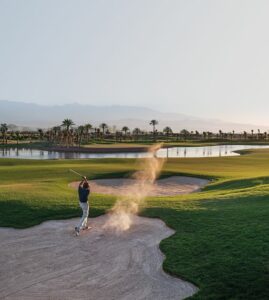
You can play golf at:
- Atlas Golf Resort Marrakech; address: km 5
- Amelkis Golf De Marrakech TEL: 05.24.40.44.14
- Golf Assoufid Marrakech; Address: 1W Avenue Mohammed 5; TEL: 05.25.06.07.77
- Samanah Country Club; address: Golf Course Km 14 Route D’Amizmiz
- Royal Golf Marrakech
- Golf Montgomerie Marrakech; address: The Montgomerie, Avenue Guemassa, Marrakech, Morocco; Tel: 05.24.39.06.44
- Noria Golf Club: address: Rue de Tahanaoute, Km 5; TEL: 05.24.38.38.59
- AL Maaden Golf Marrakech; address: Al Maaden Golf Resort, Marrakech, TEL: 05.24.40.40.01
- Golf Palmeraie Marrakech Address: Circuit Palmeraie
- Soccer:

You can play soccer at:
- Urbain 5; address: Qi azli lot industriel 2eme tranche lot n°15 Near cola, Marrakech 40000; phone: 06-06-48-64-87
- Foot 5 Kech; Address: km 11, Route de Fes, Alouidane, Marrakesh; Phone: 0622-378187
- Juventus Academy Marrakech; Address: M2R2+48M, Unnamed Road, Marrakech Phone: 0665-306655
- El Arabi Brams Soccer; Address: Ouahat Sidi Brahim, Route de benrahmoune, Marrakech 40000; Phone: 0632-156753
- Tennis:
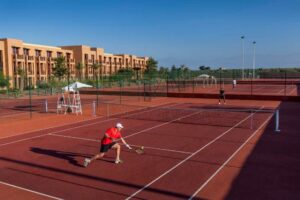
Places to play tennis in Marrakech at:
- Marrakech Sport Center; Address: Km1, Fakhara, Rte d’Essaouira, Marrakech 40000; Phone: 0662-204186
- Atlas Tennis Marrakech; Address: Route de l’ourika- KM 10. Circle Oudaya – Douar El Barakate Cf، 40000; Phone : 0611-546635
- Tennis Academy Marrakech; Address: 210,0m, Route de Targa, Marrakech 40000, Phone: 0653-890162
- Royal Tennis Club of Marrakech; Address: Rue Oued El Makhazine, Marrakech 40000; Telephone: 05244-31902
- International Marrakech Tennis Academy ; Address: km1 Fakhara، Rte d’Essaouira, Marrakesh 40000; Phone: 0661-547945
- Basketball :
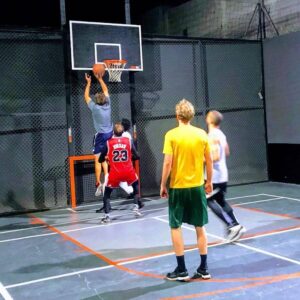
Places to play basketball in Marrakech at:
- F5 Marrakech Center; Address: 10 Rte de Fes, Marrakech; Phone: 0622-378187
- F5 Sports Club; Address: km 11, Route de Fès, Alouidane, Marrakech; Phone: 0622-378187
- Marrakech Sports Center; Address : Km1, Fakhara, Rte d’Essaouira, Marrakech 40000; Telephone: 0662-204186
- Boxing:
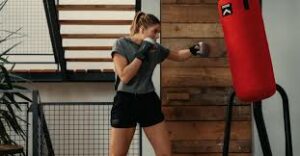
Places to do Boxing in Marrakech:
- Umma Sport; Address: Rue El Imam Malik; Tel: 06.82.16.80.66
- Marrakech Muay Thai Kick Boxing; Address: Les Bains D’Orient, Marrakech, 214 Arset Aouzal RD,Marrakech; Tel: 06.30.69.93.06
- Kriss Boxing club; Address: 17 Rue Mauritanie, Marrakech; Tel: 06.65.67.26.62
- Gym Champions of Tomorrow, Marrakech; Address: Tachfine 1 Bloc A Hay Alizdihar, Marrakech.
- Athletics:

Marrakech is the capital of African and world athletics.
The athletics halls in Marrakech:
- Urban Complex 5; Address: Gi azil industrial lot 2éme tranche lot n°15 near coca cola factory; Telephone: 06.06.48.64.87
- Marrakech Sport Center; Address: Km 1, Fakhara , Route d’Essaouira ,Marrakech; Telephone: 06.62.20.41.86
- Alpha form; Address: 6 Rue Masmoudi ,Rte de Targa ,Marrakech ; Phone: 05.24.49.08.98
- Crossfit Sirocco, Marrakech ; Address: Rue Casablanca, Marrakech ; Number: 06.65.77.64.77
- Rugby:

A place where you can play rugby:
- Kostokech -Parc des Princes
- Niece Zurich Club Rugby Swiss; Address: Hay Hassani, block 33 num 873; Tel: 07.67.65.31.81
- Fan zone ; Address: Rue Ibrahim El Mazini Casino de Marrakech Es Saadi; Tel: 06.37.31.40.16
